
Speechwriting

13 Presentation Aids
A Picture is Worth a Thousand Words
In this chapter . . .
Most public speeches given today are supplemented by presentation aids. While these can be useful in providing a visual element and helping clarify speech, if used poorly they can be more distracting. In this chapter we cover both technological presentation aids such as slide shows as well as other less conventional methods.
When you perform a speech, your audience members will experience your presentation through all five of their senses: hearing, vision, smell, taste, and touch. In some speaking situations, the speaker appeals only to the sense of hearing. But the speaking event can be greatly enriched by appeals to the other senses. This is the role of presentation aids.
Presentation aids are the resources beyond the speech words and delivery that a speaker uses to enhance the message conveyed to the audience. The type of presentation aids that speakers most typically make use of are visual aids: slideshows, pictures, diagrams, charts and graphs, maps, and the like. Audible aids include musical excerpts, audio speech excerpts, and sound effects. A speaker may also use fragrance samples or food samples as olfactory (sense of smell) or gustatory (sense of taste) aids. Finally, presentation aids can be three-dimensional objects, animals, and people.
When used correctly, presentation aids can significantly improve the quality of a speech performance.
Why Use Presentation Aids
Public speakers can deploy presentation aids for many useful reasons, including to highlight important points, clarify confusing details, amuse the audience, express emotions that are impossible to convey through words alone, and much more.
Presentation Aids Support Audience Understanding
As a speaker, your most basic goal is to help your audience understand your message. Presentation aids can reduce the possibility of misunderstanding. Presentation aids do this by clarifying or emphasizing what you are saying in your speech.
Clarification is important in a speech because if some of the information you convey is unclear, your listeners will come away puzzled or possibly even misled. Presentation aids can help clarify a message if the information is complex or if the point being made is a visual one.
Clarifying is especially important when a speaker wants to help audience members understand a visual concept. For example, if a speaker is talking about the importance of petroglyphs in Native American culture, just describing the petroglyphs won’t completely help your audience to visualize what they look like. Instead, showing an example of a petroglyph, as in Figure 1.1 (“Petroglyph”) can more easily help your audience form a clear mental image of your intended meaning.

Another way presentation aids improve understanding is through emphasis. When you use a presentational aid for emphasis, you impress your listeners with the importance of an idea. In a speech on rising levels of CO2, you might show a chart. When you use a chart like the one in Figure 1.2 (“Global CO2 Emissions”) you give a pictorial emphasis on the changes in levels of CO2.

Presentation Aids Help Retention and Recall
Presentation aids can also increase the audience’s chances of remembering your speech. An image can serve as a memory aid to your listeners. Moreover, people remember information that is presented in sequential steps more easily than if that information is presented in an unorganized pattern. When you use a presentation aid to display the organization of your speech (such as can be done with PowerPoint slides), you’ll help your listeners to observe, follow, and remember the sequence of information you conveyed to them. This is why some instructors display a lecture outline for their students to follow during class and why a slide with a preview of your main points can be helpful as you move into the body of your speech.
Another advantage of using presentation aids is that they can boost your memory while you’re speaking. Using your presentation aids while you rehearse your speech will familiarize you with the association between a given place in your speech and the presentation aid that accompanies that material.
Presentation Aids Add Variety and Interest
Furthermore, presentation aids simply make your speech more interesting. For example, wouldn’t a speech on varieties of roses have greater impact if you accompanied your remarks with a picture of each rose? Similarly, if you were speaking to a group of gourmet cooks about Indian spices, you might want to provide tiny samples of spices that they could smell and taste during your speech.
Presentation Aids Enhance a Speaker’s Credibility
Even if you give a good speech, you run the risk of appearing unprofessional if your presentation aids are poorly executed. Conversely, a high-quality presentation will contribute to your professional image. This means that in addition to containing important information, your presentation aids must be clear, uncluttered, organized, and large enough for the audience to see and interpret correctly. Misspellings and poorly designed presentation aids can damage your credibility as a speaker. If you focus your efforts on producing presentation aids that contribute effectively to your meaning, that look professional, and that are managed well, your audience will appreciate your efforts and pay close attention to your message.
Types of Presentation Aids
Slideshow: When we think of public speaking presentation aids, our thoughts go first to a slideshow. Slide presentation software is the most common tool used by speakers to accompany their speeches. The most well-known one is PowerPoint, although there are several others like Prezi and Keynote. A slideshow is a presentation aid that is made up of slides that typically contain words, images, or a combination of both.
Video: A speaker may wish to show the audience a clip of a video or other moving image in their speech. This can be played stand-alone or incorporated into a slideshow.
Music or Sound: Similarly, sound and music can be used as a presentation aid, recorded or live. Similarly, a sound recording could be played stand-alone or incorporated into a slideshow.
Physical Objects: A speaker may bring in a model, or other physical object, as an aid to presentation. For example, if you were doing a speech about the importance of emotional support animals, you might bring in a dog.
People: It is possible to use a person as a presentation aid, as in the case of demonstrations.
Other Aids: Other “low-tech” presentation aids include printed handouts, whiteboards, and flipcharts.
The sections that follow will discuss each of these types in more depth.
Designing Slideshows
In many industries and businesses, there is an assumption that speakers will use presentation slideshows. They allow visualization of concepts, they are easily portable, and they can be embedded with videos and audio. You’ll probably be expected to have slide presentations in future assignments in college. Knowing how to use them, beyond the basic technology, is vital to being a proficient presenter.
But when do presentation slides become less effective? We have all sat through a presenter who committed the common error of putting far too much text on the slide. When a speaker does this, the audience is confused—do they read the text or listen to the speaker? An audience member can’t do both. Then, the speaker feels the need to read the slides rather than use PowerPoint for what it does best, visual reinforcement and clarification.
We have also seen many poorly designed PowerPoint slides, either through haste or lack of knowledge: slides where the graphics are distorted (elongated or squatty), words and graphics not balanced, text too small, words printed over photographs, garish or nauseating colors, or animated figures left up on the screen for too long and distracting the audience.
There are principles you can follow to create slides and slideshows that are effective. In addition to the rules below, Microsoft offers tips on best practices for PowerPoint slides.
Unity and Consistency
Generally, it’s best to use a single font for the text on your visuals so that they look like a unified set. Or you can use two different fonts in consistent ways, such as having all headings and titles in the same font and all bullet points in the same font. Additionally, the background should remain consistent.
Each slide should have one message, often only one photo or graphic. The audience members should know what they are supposed to look at on the slide.
Another area related to unity and consistency is the use of animation or movement. There are three types of animation in slideshows:
- little characters or icons that have movement. These may seem like fun, but they can be distracting.
- movement of text or objects on and off the screen. Although using this function takes up time when preparing your slides, it’s very useful. You can control what your audience sees. It also avoids bringing up all the text and material on a slide at one time.
- slide transitions, which is the design of how the next slide appears.
Emphasis, Focal Point, and Visibility
Several points should be made about how to make sure the audience sees what they need to see on the slides.
- make sure the information is large enough for the audience to see. Text being at least 22-point font is best for visibility.
- the standard rule for amount of text is that you should have no more than seven horizontal lines of text and the longest line should not exceed seven words.
- you should also avoid too many slides. Less sometimes really is more. Again, there is no fixed rule, but a ten-minute speech probably needs fewer than ten slides.
- Good contrast between the text and background is extremely important. Sans serif fonts such as Arial, Tahoma, and Verdana are better for reading from screens than serif fonts such as Times New Roman, or Garamond.
Fonts, color, clip art, photographs, and templates all contribute to tone, which is the attitude being conveyed in the slides. If you want a light tone, such as for a speech about cruises, some colors (springtime, pastel, cool, warm, or primary colors) and fonts (such as Comic Sans) and lots of photographs will be more appropriate. For a speech about the Holocaust, more somber colors and design elements would be more fitting, whereas clip art would not be.
Scale and Proportion
Although there are several ways to think about scale and proportion, we will discuss two here.
First, bullet points. Bullet points infer that the items in the bulleted list are equal, and the sequence doesn’t matter. If you want to communicate order, sequence, or priority, then use numbers. Bullet points should be short—not long, full sentences—but at the same time should be long enough to mean something. In a speech on spaying and neutering pets, the bullet point “pain” may be better replaced with “Pet feels little pain.”
Second, when you’re designing your slides, it’s best to choose a template and stick with it. If you input all your graphics and material and then change the template, the format of the slide will change, in some cases dramatically, and you’ll have distorted graphics and words covered up. You’ll then have to redesign each slide, which can be unnecessarily time-consuming.
Suitable Visual Images
Often, a speaker alternates text slides with slides containing visual images. Sometimes, a slideshow is made up entirely of images. Let’s look at the kinds of images you might use in a slideshow.
Charts : A chart is commonly defined as a graphical representation of data (often numerical) or a sketch representing an ordered process. Whether you create your charts or do research to find charts that already exist, it’s important for them to exactly match the specific purpose in your speech. Three common types of charts are statistical charts , sequence-of-steps chart , and decision trees . Graphs : A graph is a pictorial representation of the relationships of quantitative data using dots, lines, bars, pie slices, and the like. Common graphs speakers utilize in their speeches include line graphs, bar graphs, pie graphs, and pictographs. Diagrams: Diagrams are drawings or sketches that outline and explain the parts of an object, process, or phenomenon that can’t be readily seen. Maps : Maps are extremely useful if the information is clear and limited. There are all kinds of maps, including population, weather, ocean current, political, and economic maps. Photographs: and/or Drawings : Sometimes a photograph or a drawing is the best way to show an unfamiliar but important detail. Audiences expect high quality photographs, and as with all presentation aids, they should enhance the speech.
Using Video and/or Audio Recordings
Another particularly useful type of presentation aid is a video or audio recording. Whether it’s a short video from a website such as YouTube or Vimeo, a segment from a song, or a piece of a podcast, a well-chosen video or audio recording may be a good choice to enhance your speech.
There is one major warning to using audio and video clips during a speech: don’t forget that they are supposed to be aids to your speech, not the speech itself. Be sure to avoid these five mistakes that speakers often make when using audio and video clips:
- Avoid choosing clips that are too long for the overall length of the speech.
- Practice with the audio or video equipment prior to speaking. Fiddling around will not only take your audience out of your speech but also have a negative impact on your credibility. Be sure that the speakers on the computer are on and at the right volume level.
- Cue the clip to the appropriate place prior to beginning your speech.
- In addition to cueing up clip to the appropriate place, the browser window should be open and ready to go.
- The audience must be given context before a video or audio clip is played, specifically what the clip is and why it relates to the speech. At the same time, the video should not repeat what you have already said but add to it.
Objects or Models
Objects refer to anything you could hold up and talk about during your speech, as in Figure 1.3. If you’re talking about the importance of not using plastic water bottles, you might hold up a plastic water bottle and a stainless-steel water bottle as examples.

We can often use ourselves or other people to adequately demonstrate an idea during our speeches. If your speech is about ballroom dancing or ballet, you might use your body to demonstrate the basic moves in the cha-cha or the five basic ballet positions.
In some cases, such as for a demonstration speech, you might want to ask someone else to serve as your presentation aid. You should arrange ahead of time for a person (or persons) to be an effective aid—don’t assume that an audience member will volunteer on the spot. The transaction between you and your human presentation aid must be appropriate, especially if you’re going to demonstrate something like a dance step. In short, make sure your helper will know what is expected of them and consents to it.
Other Types of Presentation Aids
Dry-erase board.
Numerous speakers utilize dry-erase boards effectively. Typically, these speakers use the dry-erase board for interactive components of a speech. For example, maybe you’re giving a speech in front of a group of executives. You may have a PowerPoint all prepared, but at various points in your speech you want to get your audience’s responses.
If you ever use a chalk or dry-erase board, follow these four simple rules:
- Write large enough so that everyone in the room can see.
- Print legibly; don’t write in cursive script.
- Write short phrases; don’t take time to write complete sentences.
- Be sure you have markers that will not go dry; clean the board afterward.
A flipchart is useful for situations when you want to save what you have written for future reference or to distribute to the audience after the presentation. As with whiteboards, you’ll need good markers and readable handwriting, as well as a strong easel to keep the flipchart upright.
Handouts are appropriate for delivering information that audience members can take away with them.
- make sure the handout is worth the trouble of making, copying, and distributing it. Does the audience really need the handout?
- make sure to bring enough copies of the handout for each audience member to get one.
- Stay away from providing a single copy of a handout to pass around. It’s distracting and everyone will see it at different times in the speech, which is also true about passing any object around the room.
- If you have access to the room ahead of time, place a copy of the handout at or on each seat in the audience. If the handout is a “takeaway,” leave it on a table near the door so that those audience members who are interested can take one on their way out.
How to Perform with Presentation Aids
Just as everything else in public speaking performance, it takes practice to effectively perform a speech while seamlessly incorporating presentation aids. Below are some tips and tricks for how to include presentation aids as part of a strong speech delivery.
Speaking with a Slide Presentation
The rhythm of your slide presentation should be reasonably consistent—you would not want to display a dozen different slides in the first minute of a five-minute presentation and then display only one slide per minute for the rest of the speech.
Whether using a remote “clicker” or the attached mouse, you should connect what is on the screen to what you’re talking about at the moment. Put reminders in your notes about when you need to change slides during your speech.
A basic presentation rule is to only show your visual aid when you’re talking about it and remove it when you no longer are talking about it. If you’re using PowerPoint and if you’re not talking about something on a slide, put a black slide between slides in the presentation so that you have a blank screen for parts of the speech.
Some other practical considerations are as follows:
- Be sure the file is saved in a format that will be “readable” on the computer where you’re presenting.
- Any borrowed graphic must be cited on the slide where it’s used; the same would be true of borrowed textual material. Putting your sources only on the last slide is insufficient.
- A strong temptation for speakers is to look at the projected image rather than the audience during the speech. This practice cuts down on eye contact, of course, and is distracting for the audience. Two solutions for that are to print your notes from the presentation slides and/or use the slides as your note structure. Also remember that if the image is on the computer monitor in front of you, it’s on the screen behind you.
- Always remember—and this can’t be emphasized enough—technology works for you, not you for the technology. The presentation aids are aids, not the speech itself.
- As mentioned before, sometimes life happens—technology does not work. It could be that the projector bulb goes out or the Internet connection is down. The show must go on.
- If you’re using a video or audio clip from an Internet source, it’s probably best to hyperlink the URL on one of the slides rather than minimize the program and change to the Internet site.
- Finally, it’s common for speakers to think “the slide changes, so the audience know there is a change, so I don’t need a verbal transition.” Please don’t fall into this trap. Verbal transitions are just as, and maybe more, necessary for a speech using slides.
- Do not obscure your visual aid– practice standing to the side of your aid when rehearsing.
- Remember to keep eye contact with the audience, even when referring to a visual aid. Certainly, never turn your back on the audience!
- Rehearse with your visual aids. You want to have transitions between showing and hiding visual aids to be seamless, with as little filler time or distractions as possible. Practice makes perfect in this regard.
- As will be mentioned again below: simplicity is key. Avoid anything too distracting, too complicated, anything that will take a lot of time away from your speech content. You always want aids to supplement, not supplant, your speech content and delivery.
Avoiding Problems with Presentation Aids
Presentation aids can be tricky to use, as they can easily distract from the focus of your speech: the content and your delivery. One tip to keep in mind is to use only as many presentation aids as necessary to present your message or to fulfill your classroom assignment. The number and the technical sophistication of your presentation aids should never overshadow your speech.
Another important consideration is technology. Keep your presentation aids within the limits of the working technology available to you. As the speaker, you’re responsible for arranging the things you need to make your presentation aids work as intended. Test the computer and projector setup. Have your slides on a flash drive AND send it to yourself as an attachment or upload to a Cloud service. Have an alternative plan prepared in case there is some glitch that prevents your computer-based presentation aids from being usable. And of course, you must know how to use the technology.
More important than the method of delivery is the audience’s ability to see and understand the presentation aid. It must deliver clear information, and it must not distract from the message. Avoid overly elaborate or confusing presentation aids. Instead, simplify as much as possible, emphasizing the information you want your audience to understand. Remember the acronym KISS: Keep it Simple, Speaker!
Another thing to remember is that presentation aids don’t “speak for themselves.” When you display a visual aid, you should explain what it shows, pointing out and naming the most important features.
To finish this chapter, we will recap and remind you about the principles of effective presentation aids. Whether your aid is a slide show, object, a person, or dry erase board, these standards are essential:
- Presentation aids must be easily seen or heard by your audience.
- Presentation aids must be portable, easily handled, and efficient.
- Presentation aids should disappear when not in use.
- Presentation aids should be aesthetically pleasing, which includes in good taste. Avoid shock value just for shock value.
Media Attributions
- Petroglyphs © Jim Bouldin is licensed under a CC BY-SA (Attribution ShareAlike) license
- Rise in Global CO2 Emissions, 2022 © International Energy Agency is licensed under a CC BY (Attribution) license
- Speech with Prop © Ralf Rebmann is licensed under a CC BY-SA (Attribution ShareAlike) license
Public Speaking as Performance Copyright © 2023 by Mechele Leon is licensed under a Creative Commons Attribution-NonCommercial-ShareAlike 4.0 International License , except where otherwise noted.

Want to create or adapt books like this? Learn more about how Pressbooks supports open publishing practices.
13 Presentation Aids
Learning objectives.
- Identify the advantages and disadvantages of the ways to use presentation aids.
- Understand the range of choices for presentation aids.
- Explain the role of careful planning and good execution when using presentation aids.
What Are Presentation Aids?
When you deliver a speech, you are presenting much more than just a collection of words and ideas. Because you are speaking “live and in person,” your audience members will experience your speech through all five of their senses: hearing, vision, smell, taste, and touch. In some speaking situations, the speaker appeals only to the sense of hearing, more or less ignoring the other senses. The speaking event can be greatly enriched by appeals to the other senses using presentation aids.
Presentation aids are the resources beyond the speech itself that a speaker uses to enhance the message conveyed to the audience. The type of presentation aids speakers most typically use are visual aids: pictures, diagrams, charts and graphs, maps, and the like. Audible aids include musical excerpts, audio speech excerpts, and sound effects. A speaker may also use fragrance samples or food samples as olfactory (smell) or gustatory (taste) aids. Presentation aids can be three-dimensional objects, animals, and people, and they can unfold over a period of time, as in the case of a how-to demonstration.
As you can see, the range of possible presentation aids is almost infinite. However, to be effective, each presentation aid a speaker uses must be a direct, uncluttered example of a specific element of the speech. It is understandable that someone presenting a speech about Abraham Lincoln might want to include a picture of him. However, because most people already know what Lincoln looked like, the picture would not contribute much to the message (unless, perhaps, the message was specifically about the changes in Lincoln’s appearance during his time in office). Other visual artifacts are likely to deliver information more directly relevant to the speech. For example, when giving a speech about Lincoln, a speaker may use a diagram of the interior of Ford’s Theater where Lincoln was assassinated, a draft of the messy and much-edited Gettysburg Address, or a photograph of the Lincoln family. The key is that each presentation aid must directly express an idea in your speech.
Moreover, presentation aids must be used at the specific time you are presenting the ideas related to the aid. For example, if you are speaking about coral reefs and one of your supporting points is about the location of the world’s major reefs, it will make sense to display a map of these reefs while you’re talking about their location. If you display it while you are explaining what coral actually is, or after you have completed your speech, the map will not serve as a useful visual aid. In fact, it’s likely to be a distraction.
Presentation aids must also be easy to use. At a conference on organic farming, one of the authors watched as the facilitator opened the orientation session by creating a conceptual map of our concerns, using a large newsprint pad on an easel. In his shirt pocket, there were wide-tipped felt markers in several colors. As he was using the black marker to write the word “pollution,” he dropped the cap on the floor, and it rolled a few inches under the easel. When he bent over to pick up the cap, all the other markers fell out of his pocket. They rolled about too, and when he tried to retrieve them, he bumped the easel, leading the easel and newsprint pad to tumble over on top of him. The audience responded with amusement and thundering applause, but the serious tone of his speech was ruined. The next two days of the conference were punctuated with allusions to the unforgettable orientation speech. Markers falling across the floor is not how you will want your speech to be remembered.
To be effective, presentation aids must also be easy for the listeners to see and understand. In this chapter, we will present some principles and strategies to help you incorporate hardworking, effective presentation aids into your speech. We will begin by discussing the functions that a good presentation aid fulfills. Next, we will explore some of the many types of presentation aids and how best to design and utilize them. We will also describe various media that can be used for presentation aids and will conclude with tips for successful preparation and use of presentation aids in a speech.
Presentation aids are the resources beyond the speech itself that a speaker uses to enhance the message conveyed to the audience.
Functions of Presentation Aids
Why should you use presentation aids? If you have prepared and rehearsed your speech adequately, shouldn’t a good speech with a good delivery be enough to stand on its own? While it is true that impressive presentation aids will not rescue a poor speech, it is also important to recognize that a good speech can often be made better by the strategic use of presentation aids.
Presentation aids can fulfill several functions: they can serve to improve your audience’s understanding of the information you are conveying, enhance audience memory and retention of the message, add variety and interest to your speech, and enhance your credibility as a speaker. Let’s examine each of these functions.
Improving Audience Understanding
Human communication is a complicated process that often leads to misunderstandings. If you are like most people, you can easily remember incidents when you misunderstood a message or when someone else misunderstood what you said to them. Misunderstandings happen in public speaking just as they do in everyday conversations.
One reason for misunderstandings is the fact that perception and interpretation are highly complex individual processes. Most of us have seen the image in which, depending on your perception, you see either the outline of a vase or the facial profiles of two people facing each other. These types of images show how interpretations can differ. Your presentations must be based on careful thought and preparation to maximize the likelihood that your listeners will understand the intention of your presentation.
As a speaker, one of your basic goals is to help your audience understand your message. To reduce misunderstanding, presentation aids can be used to clarify or to emphasize.
Clarification is important in a speech because if some of the information you convey is unclear, your listeners will come away puzzled or possibly even misled. Presentation aids can help clarify a message if the information is complex or if the point being made is a visual one.
If your speech is about the impact of the Coriolis effect on tropical storms, for instance, you will have great difficulty clarifying it without a diagram because the process is a complex one. The diagram in Figure 1: The Coriolis Effect would be helpful because it shows the audience the interaction between equatorial wind patterns and wind patterns moving in other directions. The diagram allows the audience to process the information in two ways: through your verbal explanation and through the visual elements of the diagram.
Figure 1: The Coriolis Effect
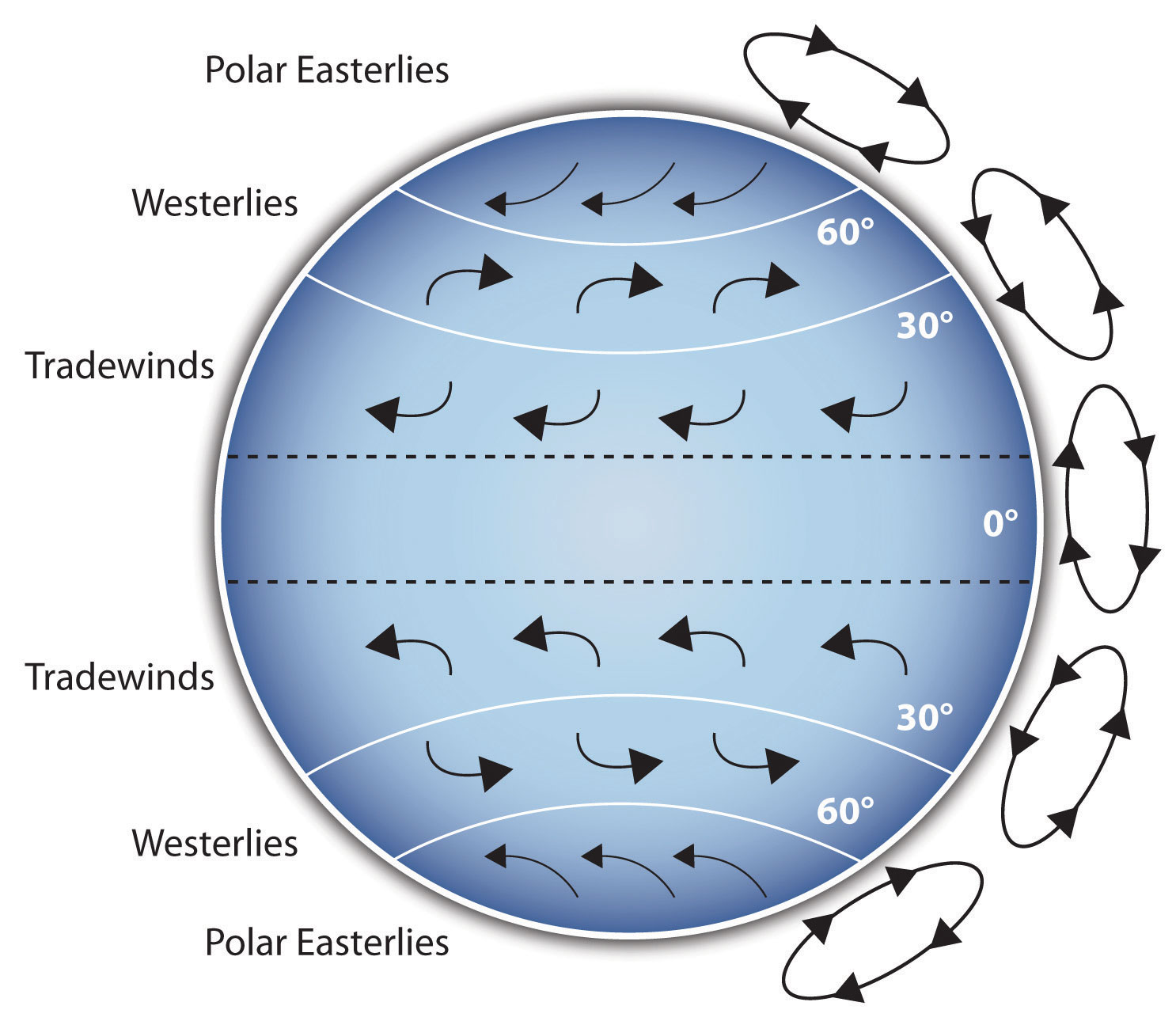
Figure 2: Model of Communication is another example of a diagram that maps out the process of human communication. In this image, you clearly have a speaker and an audience (albeit slightly abstract), with the labels of the source, channel, message, receivers, and feedback to illustrate the basic linear model of human communication.
Figure 2: Model of Communication
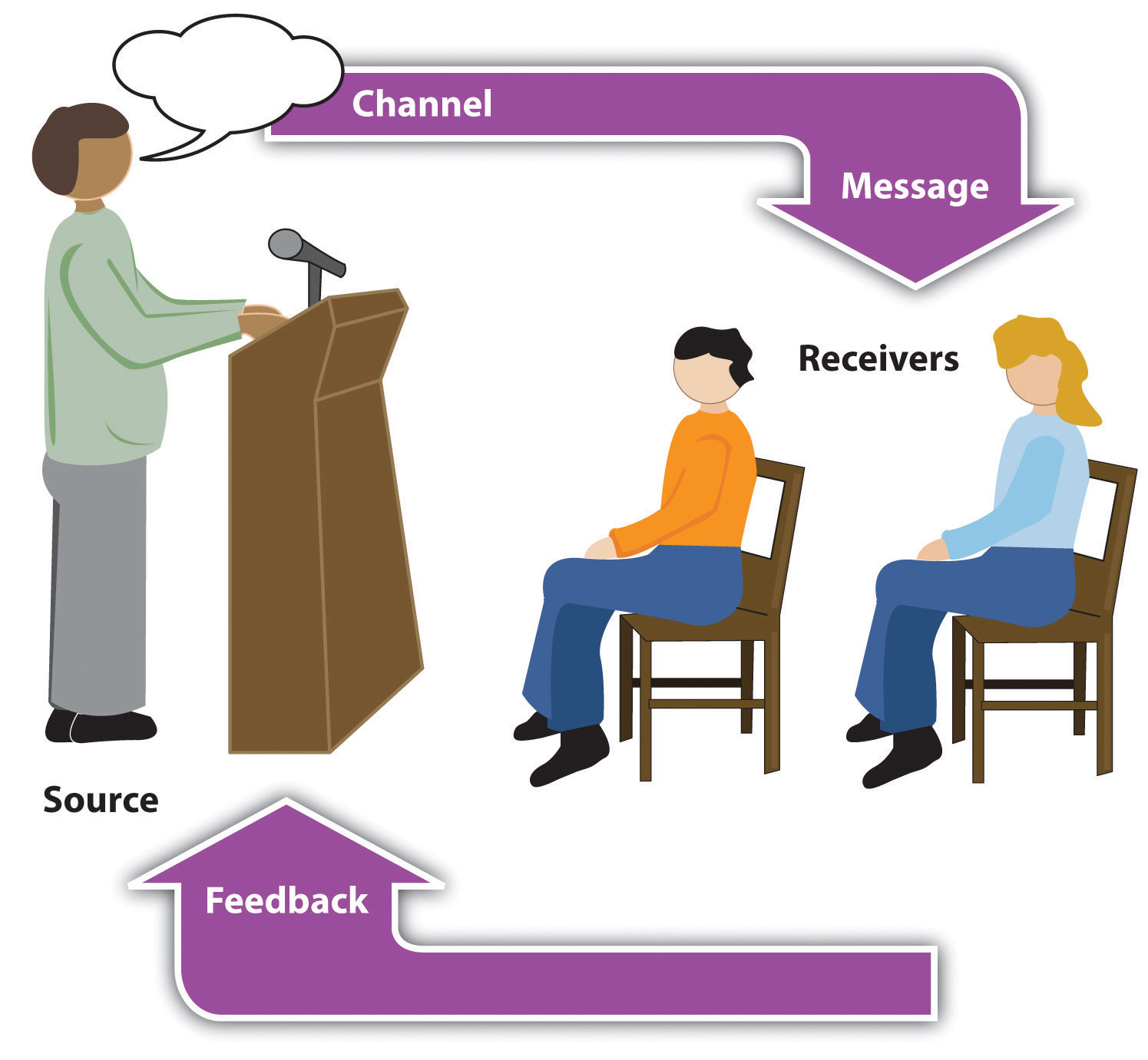
Another aspect of clarifying occurs when a speaker wants to visually help audience members understand a visual concept. For example, if a speaker is talking about the importance of petroglyphs in Native American culture, just describing the petroglyphs won’t completely help your audience to visualize what they look like. Instead, showing an example of a petroglyph, as in Figure 3: Petroglyph , could help your audience form a clear mental image of your intended meaning.
Figure 3: Petroglyph
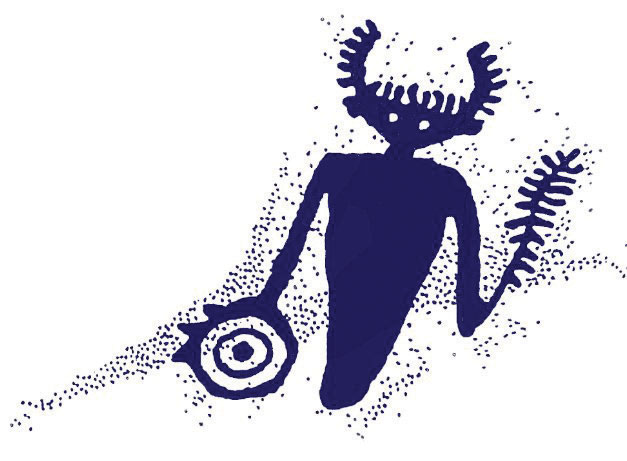
Emphasizing
When you use a presentational aid for emphasis, you impress your listeners with the importance of an idea. In a speech on water conservation, you might try to show the environmental proportions of the resource. When you use a conceptual drawing like the one in Figure 4: Planetary Water Supply , you show that if the world water supply were equal to ten gallons, only ten drops would be available and potable for human or household consumption. This drawing is effective because it emphasizes the scarcity of useful water and draws attention to this important information in your speech.
Figure 4 : Planetary Water Supply
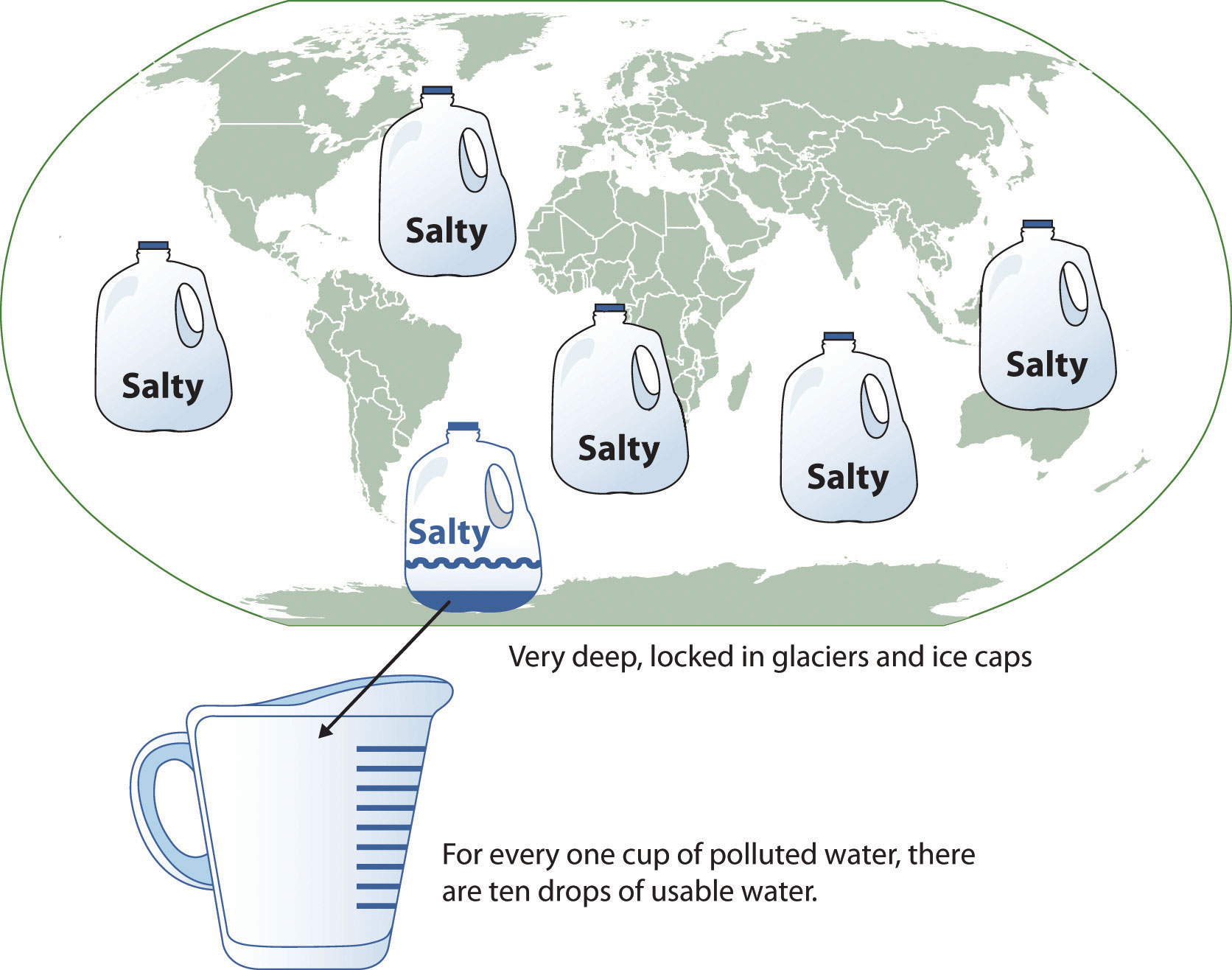
Another way to visually emphasize information in your speech is to zoom in on a specific aspect of interest within your speech. In Figure 5: Chinese Lettering Amplified, we see a visual aid used in a speech on the importance of various parts of Chinese characters. On the left side of the visual aid, we see how the characters all fit together, with an emphasized version of a single character on the right.
Figure 5: Chinese Lettering Amplified
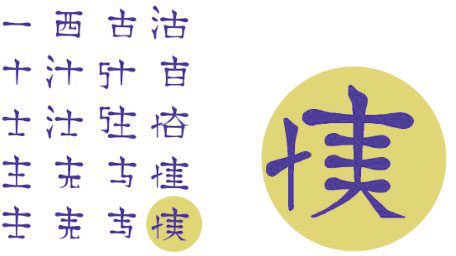
Wikimedia Commons – public domain.
Aiding Retention and Recall
The second function that presentation aids can serve is to increase the audience’s chances of remembering your speech. A 1996 article by the US Department of Labor summarized research on how people learn and remember. The authors found that “83% of human learning occurs visually, and the remaining 17% through the other senses—11% through hearing, 3.5% through smell, 1% through taste, and 1.5% through touch” (United States Department of Labor, 1996). Mostly, people learn through seeing things, so the visual component of learning is very important. The article goes on to note that information stored in long-term memory is also affected by how we initially learn the material. In a study of memory, learners were asked to recall information after a three day period. The researchers found that they retained 10 percent of what they heard from an oral presentation, 35 percent from a visual presentation, and 65 percent from a visual and oral presentation (Lockard & Sidowski, 1961). It’s amazing to see how the combined effect of both the visual and oral components can contribute to long-term memory.
For this reason, exposure to a visual image can serve as a memory aid to your listeners. When your graphic images deliver information effectively, and when your listeners understand them clearly, audience members are likely to remember your message long after your speech is over.
Moreover, people can remember information that is presented in sequential steps more easily than if that information is presented in an unorganized pattern. When you use a presentation aid to display the organization of your speech, you will help your listeners to observe, follow, and remember the sequence of information you conveyed to them. This organization is why some instructors display a lecture outline for their students to follow during class.
An added plus of using presentation aids is that they can boost your memory while you are speaking. Using your presentation aids while you rehearse your speech will familiarize you with the association between a given place in your speech and the presentation aid that accompanies that material. For example, if you are giving an informative speech about diamonds, you might plan to display a sequence of slides illustrating the most popular diamond shapes: brilliant, marquise, emerald, and so on. As you finish describing one shape and advance to the next slide, seeing the next diamond shape will help you remember the information about it that you are going to deliver.
Adding Variety and Interest
The third function of presentation aids is to make your speech more interesting. While it is true that a good speech and a well-rehearsed delivery will already include variety in several aspects of the presentation, in many cases, a speech can be made even more interesting by the use of well-chosen presentation aids.
For example, you may have prepared a great speech to inform a group of gardeners about several new varieties of roses suitable for growing in your local area. Although your listeners will undoubtedly understand and remember your message very well without any presentation aids, wouldn’t your speech have greater impact if you accompanied your remarks with a picture of each rose? You can imagine that your audience would be even more enthralled if you could display an actual flower of each variety in a bud vase.
Similarly, if you were speaking to a group of gourmet cooks about Indian spices, you might want to provide tiny samples of spices that they could smell and taste during your speech. Taste researcher Linda Bartoshuk has given presentations in which audience members receive small pieces of fruit and are asked to taste them at certain points during the speech (Association for Psychological Science, 2011).
Enhancing a Speaker’s Credibility
Presentation aids alone will not be enough to create a professional image. As we mentioned earlier, impressive presentation aids will not rescue a poor speech. However, even if you give a good speech, you run the risk of appearing unprofessional if your presentation aids are poorly executed. Meaning, that in addition to containing important information, your presentation aids must be clear, clean, uncluttered, organized, and large enough for the audience to see and interpret correctly.
Misspellings and poorly designed presentation aids can damage your credibility as a speaker. Conversely, a high-quality presentation will contribute to your professional image. Additionally, make sure that you give proper credit to the source of any presentation aids that you take from other sources. Using a statistical chart or a map without proper credit will detract from your credibility, just as using a quotation in your speech without credit would.
If you focus your efforts on producing presentation aids that contribute effectively to your meaning, and look professional and are well handled, your audience will most likely appreciate your efforts and pay close attention to your message. That attention will help them learn or understand your topic in a new way and will thus help the audience see you as a knowledgeable, competent, credible speaker.
Types of Presentation Aids
As we saw in the example of the presentation at the organic farming conference, using presentation aids can be risky. However, with a little forethought and adequate practice, you can choose presentation aids that enhance your message and boost your professional appearance in front of an audience.
One principle to keep in mind is to use only as many presentation aids as necessary to present your message or to fulfill your classroom assignment. Although the maxim “less is more” may sound like a cliché, it really does apply in this instance. The technical sophistication of your presentation aids should never overshadow your speech.
Another important consideration is technology. Keep your presentation aids within the limits of the working technology available to you. Whether or not your classroom technology works on the day of your speech, you will still have to present. What will you do if the computer file containing your slides is corrupted? What will you do if the easel is broken? What if you had counted on stacking your visuals on a table that disappears right when you need it? You must be prepared to adapt to an uncomfortable and scary situation. These scenarios are why we urge students to go to the classroom at least fifteen minutes ahead of time to test the equipment and ascertain the condition of things they’re planning to use. As the speaker, you are responsible for arranging the items you need to make your presentation aids work as intended. Carry a roll of duct tape so you can display your poster even if the easel is gone. Find an extra chair if your table has disappeared. Test the computer setup, and have an alternative plan prepared in case there is some glitch that prevents your computer-based presentation aids from being usable. The more sophisticated the equipment is, the more prepared you should be with an alternative, even in a “smart classroom.”
More important than the method of delivery is the audience’s ability to see and understand the presentation aid. It must deliver clear information, and it must not distract from the message. Avoid overly elaborate presentation aids because they can distract the audience’s attention from your message. Instead, simplify as much as possible, emphasizing the information you want your audience to understand.
Another thing to remember is that presentation aids do not “speak for themselves.” When you display a visual aid, you should explain what it shows, pointing out and naming the most important features. If you use an audio aid, such as a musical excerpt, you need to tell your audience a specific thing to listen for. Similarly, if you use a video clip, it is up to you as the speaker to point out the characteristics of the video that support the point you are making.
Although there are many useful presentation tools, you should not attempt to use every one of these tools in a single speech. Your presentation aids should be designed to look like a coherent set. For instance, if you decide to use three slides and a poster, all four of these visual aids should make use of the same type font and basic design.
Now that we’ve explored some basic hints for preparing visual aids, let’s look at the most common types of visual aids: charts, graphs, representations, objects/models, and people.
A chart is a graphical representation of data (often numerical) or a sketch representing an ordered process. Whether you create your charts, or do research to find charts that already exist, it is important for them to exactly match the specific purpose in your speech. In the rest of this section, we’re going to explore three common types of charts: statistical charts, sequence-of-steps chart, and decision trees.
Statistical Charts
For most audiences, statistical presentations must be kept as simple as possible, and they must be explained. Unless you are familiar with statistics, a chart may be very confusing. When visually displaying information from a quantitative study, you need to make sure that you understand the material and can successfully explain how one should interpret the data. If you are unsure about the data yourself, then you should probably not use this type of information. Figure 6: Effects of Smoking on Different Body Systems is surely an example of a visual aid that, although it delivers a limited kind of information, does not speak for itself.
Figure 6: Effects of Smoking on Different Body Systems
Wikimedia Commons – public domain; and Wikimeida Commons – public domain.
Sequence-of-Steps Charts
Charts are also useful when you are trying to explain a process that involves several steps. The visual aid in Figure 7: Steps in Cell Reproduction depicts the process of cell division called mitosis using a sequence-of-steps chart. The chart labels the phases, which can help your audience understand the process.
Figure 7: Steps in Cell Reproduction
Wikipedia – public domain
DecisionTrees
Decision trees are useful for showing the relationships between ideas. The example in Figure 8: To Play or Not to Play shows how a decision tree could be used to determine the appropriate weather for playing baseball. As with the other types of charts, you want to be sure that the information in the chart is relevant to the purpose of your speech and that each question and decision is clearly labeled.
Figure 8: To Play or Not to Play
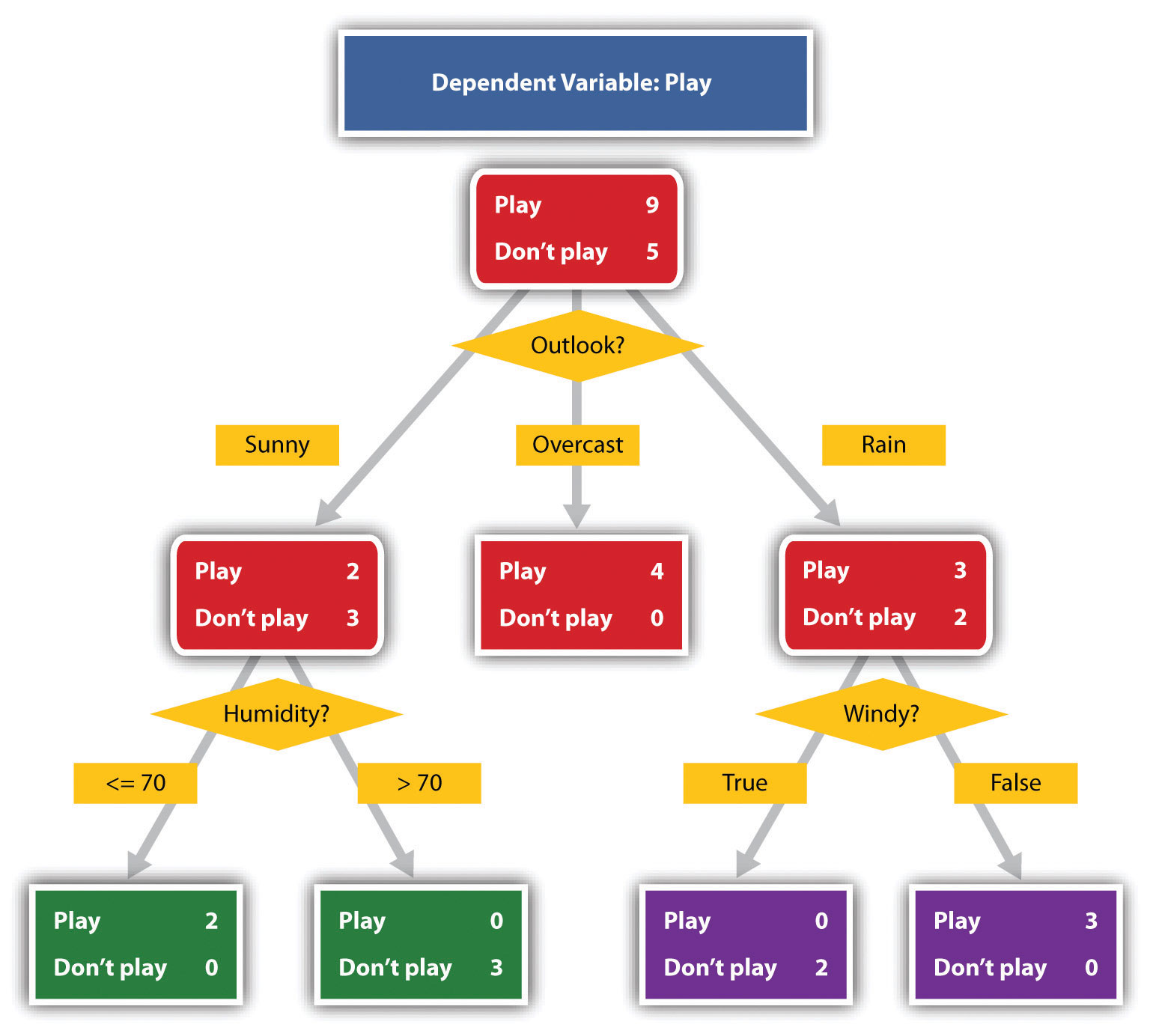
Strictly speaking, a graph may be considered a type of chart, but graphs are so widely used that we will discuss them separately. A graph is a pictorial representation of the relationships of quantitative data using dots, lines, bars, pie slices, and the like. Graphs show the variation in one variable in comparison with that of one or more other variables. Where a statistical chart may report the mean ages of individuals entering college, a graph would show how the mean age changes over time. A statistical chart may report the number of computers sold in the United States, while a graph will show the breakdown of those computers by operating systems such as Windows, Macintosh, and Linux. Public speakers can use graphs from a range of different formats. Some of those formats are specialized for various professional fields. Very complex graphs often contain too much information that is not related to the purpose of a student’s speech. If the graph is cluttered, it becomes difficult to comprehend.
In this section, we’re going to analyze types of graphs speakers frequently utilize in their speeches: line graphs, bar graphs, and pie graphs.
A line graph is designed to show trends over time. In Figure 9: Enron’s Stock Price , we see a line graph depicting the fall of Enron’s stock price from August 2000 to January 2002. Notice that although it has some steep rises, the line has an overall downward trend clearly depicting the plummeting of Enron’s stock price. Showing such a line graph helps the audience see the relationships between the numbers. The audience can also understand the information by seeing the graph much more easily than they could if the speaker just read the numbers aloud.
Figure 9: Enron’s Stock Price
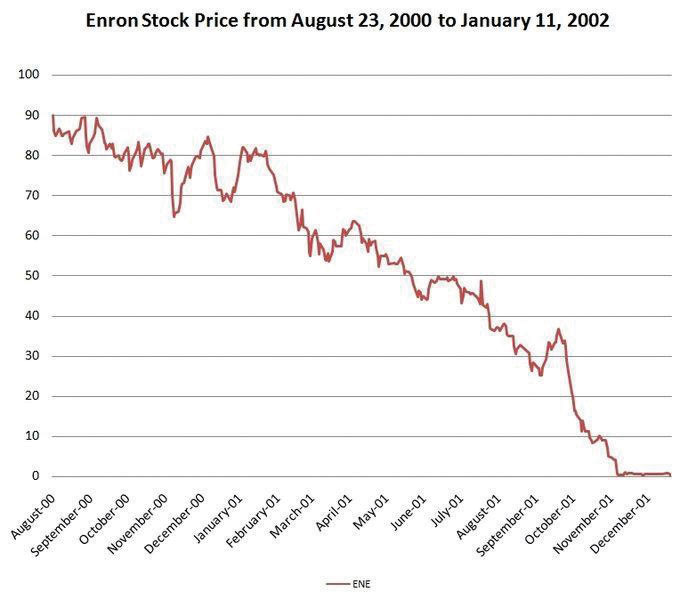
Wikimedia Common – CC BY-SA 2.0.
Bar graphs are useful for showing the differences between quantities. They can be used for population demographics, fuel costs, math ability in different grades, and many other kinds of data. The graph in Figure 10: Natural Death vs. Homicide is well designed. It is relatively simple and is carefully labeled, making it easy for you to guide your audience through the quantities of each type of death. The bar graph is designed to show the difference between natural deaths and homicides across various age groups. When you look at the data, the first grouping clearly shows that eighteen to twenty-four-year-olds are more likely to die because of a homicide than any of the other age groups.
Figure 10: Natural Death vs. Homicide

Pie graphs should be simplified as much as possible without eliminating important information. As with other graphs, the sections need to be plotted proportionally. In the pie graph shown in Figure 11: Causes of Concussions in Children , we see a clear and proportional chart that has been color-coded. Color-coding is useful when it’s difficult to fit the explanations in the actual sections of the graph. In this case, you need to include a legend, or key, to indicate what the colors in the graph mean. In this graph, audience members can see very quickly that falls are the primary reason children receive concussions.
Figure 11: Causes of Concussions in Children
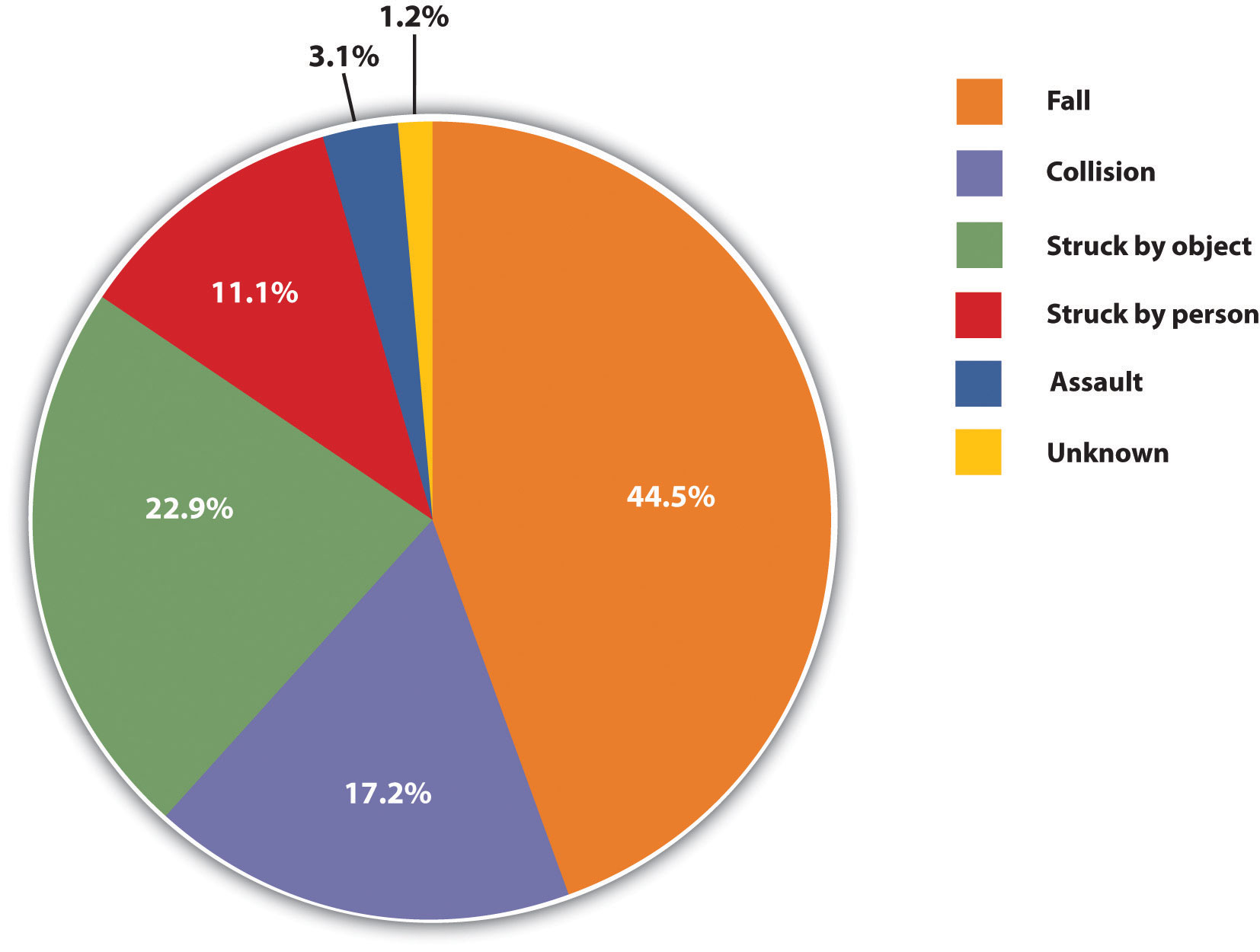
The pie graph in Figure 12: World Populations is jumbled, illegible, confusing, and overwhelming in every way. The use of color coding doesn’t help. Overall, this graph simply contains too much information and is more likely to confuse an audience than help them understand something.
Figure 12: World Populations

Representations
In the world of presentation aids, representation is the word used to classify a group of aids designed to represent real processes or objects. Often, speakers want to visually demonstrate something that they cannot physically bring with them to the speech. Maybe you’re giving a speech on the human brain, and you don’t have access to a cadaver’s brain. Instead of bringing in a real brain, you could use a picture of a brain or an image that represents the human brain. In this section, we’re going to explore four common representations: diagrams, maps, photographs, and video or recordings.
Diagrams are drawings or sketches that outline and explain the parts of an object, process, or phenomenon that cannot be readily seen. Like graphs, diagrams can be considered a type of chart, as in the case of organization charts and process flow charts.
When you use a diagram, be sure to explain each part of the phenomenon, paying special attention to elements that are complicated or prone to misunderstanding. In the example shown in Figure 13: The Human Eye , you might wish to highlight that the light stimulus is reversed when it is processed through the brain or that the optic nerve is not a single stalk as many people think.
Figure 13: The Human Eye
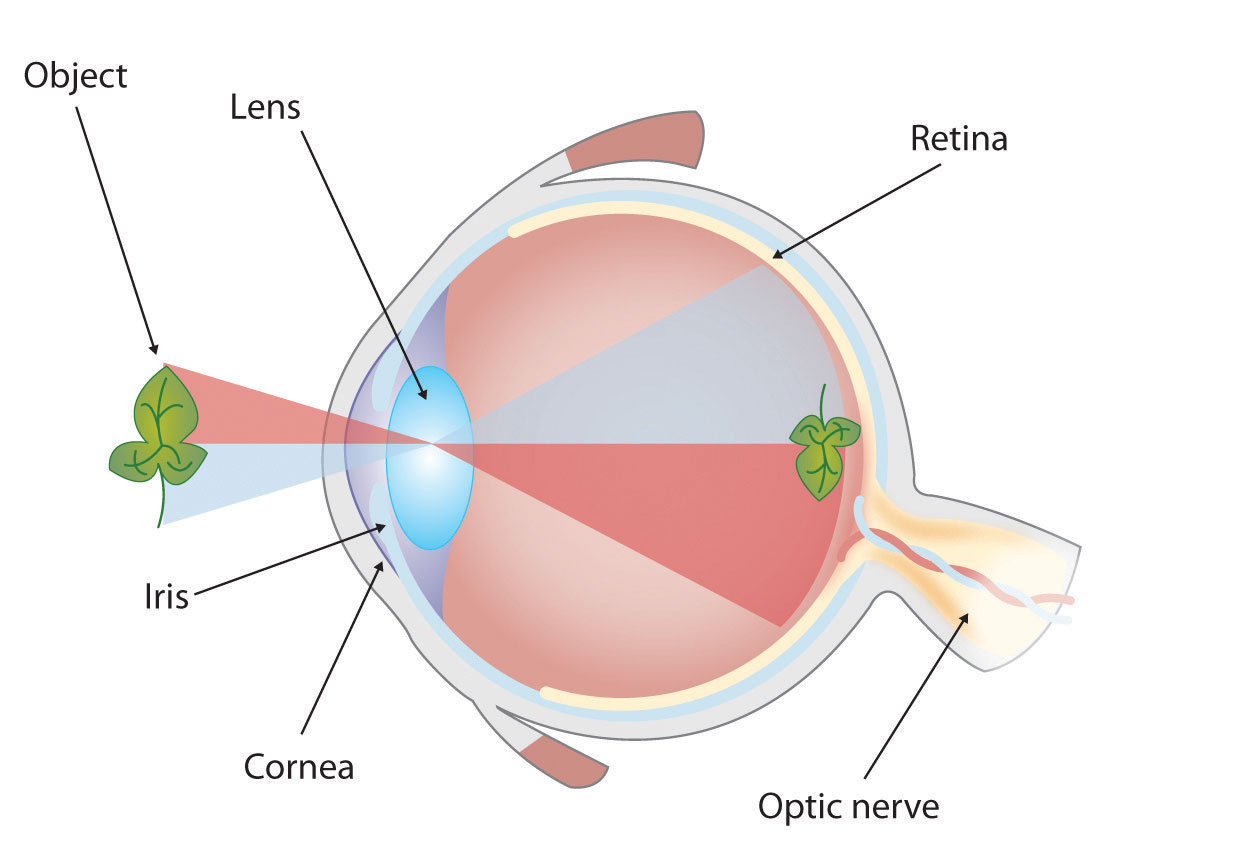
Maps are useful if the information is clear and limited. There are all kinds of maps, including population, weather, ocean current, political, and economic maps. You should be able to find the right type for the purpose of your speech. Choose a map that emphasizes the information you need to deliver.
The map shown in Figure 14: African Map with Nigerian Emphasis is simple. It clearly shows the geographic location of Nigeria. This map can be valuable for some audiences who might not be able to name and locate countries on the continent of Africa.
Figure 14: African Map with Nigerian Emphasis

Figure 15: Rhode Island Map is a map of the state of Rhode Island, and it emphasizes the complicated configuration of islands and waterways that characterize this state’s geography. Although the map does not list the names of the islands, it is helpful in orienting the audience to the direction and distance of the islands to other geographic features, such as the city of Providence and the Atlantic Ocean.
Figure 15: Rhode Island Map

Source: Map courtesy of the National Atlas of the United States.
Photographs and Drawings
Sometimes a photograph or a drawing is the best way to show an unfamiliar but important detail.
The photograph of the tall ship in Figure 17: Ship’s Rigging could be used to emphasize the sheer amount and complexity of the ship’s rigging.
Figure 17: Ship’s Rigging

Video or Audio Recordings
Another useful type of presentation aid is a video or audio recording. Whether it is a short video from a website such as YouTube or Vimeo, a segment from a song, or a piece of a podcast, a well-chosen video or audio recording may be a good choice to enhance your speech.
Imagine, for example, that you’re giving a speech on how “Lap-Band” surgeries help people lose weight. One of the sections of your speech could explain how the Lap-Band works, so you could easily show the following forty-three-second video to demonstrate the medical part of the surgery ( http://www.youtube.com/watch?v=KPuThbFMxGg ). Maybe you want to include a recording of a real patient explaining why they decided to get the Lap-Band surgery. Then, you could include a podcast like this one from the Medical University of South Carolina ( http://medicaluniversc.http.internapcdn.net/medicaluniversc_vitalstream_com/podcasts/2007/1_Treado_June_22_final.mp3 ).
There is one major caveat to using audio and video clips during a speech: do not forget that they are supposed to be aids to your speech, not the speech itself! Additionally, be sure to avoid these three mistakes that speakers often make when using audio and video clips:
- Avoid choosing clips that are too long for the overall length of the speech. If you are giving a five-minute speech, then any audio or video clip you use should be under thirty seconds in length.
- Don’t fail to practice with the audio or video equipment before speaking. If you are unfamiliar with the equipment, you’ll have a hard time trying to figure out how it works. Fiddling around with the technology will not only take your audience out of your speech, but it will also have a negative impact on your credibility.
- Don’t fail to cue the clip to the appropriate place before beginning your speech. We cannot tell you the number of times we’ve seen students spend valuable speech time trying to find a clip on YouTube or a DVD. You need to make sure your clip is ready to go before you start speaking.
Objects or Models
Objects and models are other forms of presentation aid that can be very helpful in getting your audience to understand your message. Objects refer to anything you could hold up and talk about during your speech. If you’re talking about the importance of not using plastic water bottles, you might hold up a plastic water bottle and a stainless steel water bottle as examples. If you’re talking about the percussion family of musical instruments and you own (and can play) several different percussion instruments, you can show your audience in person what they look like and how they sound.
Models , on the other hand, are re-creations of physical objects that you cannot have readily available with you during a speech. If you’re giving a speech on heart murmurs, you may be able to show how heart murmurs work by holding up a model of the human heart.
Animals and People
The next category of presentation aids is people and animals. We can often use animals and people , whether it be an animal, ourselves, or another people, to adequately demonstrate an idea during our speeches.
Animals as Presentation Aids
When giving a speech on a topic relating to animals, it is often tempting to bring an animal to serve as your presentation aid. While this can sometimes add a very engaging dimension to the speech, it carries some serious risks that you need to consider.
The first risk is that animal behavior tends to be unpredictable. You may think this won’t be a problem if your presentation aid animal is a small enough to be kept confined throughout your speech like a goldfish in a bowl or a lizard or bird in a cage. However, even caged animals can be very distracting to your audience if they run about, chirp, or exhibit other agitated behavior. The chances are great that an animal will react to the stress of an unfamiliar situation by displaying behavior that does not contribute positively to your speech.
The second risk is that some audience members may respond negatively to a live animal. In addition to fears and aversions to animals like snakes, spiders, and mice, many people have allergies to various animals.
The third risk is that some locations may have regulations about bringing animals onto the premises. If animals are allowed, the person bringing the animal may be required to bring a veterinary certificate or may be legally responsible for any damage caused by the animal.
For these reasons, before you decide to use an animal as a presentation aid, ask yourself if you could make your point equally well with a picture, model, diagram, or other representation of the animal in question.
Speaker as Presentation Aid
Speakers can often use their own bodies to demonstrate facets of a speech. If your speech is about ballroom dancing or ballet, you might use your body to demonstrate the basic moves in the cha-cha or the five basic ballet positions.
Other People as Presentation Aids
In many speeches, it can be cumbersome and distracting for the speaker to use her or his own body to illustrate a point. In such cases, the best solution is to ask someone else to serve as your presentation aid.
You should arrange ahead of time for a person (or persons) to be an effective aid. Do not assume that an audience member will volunteer on the spot. If you plan to demonstrate how to immobilize a broken bone, your volunteer must know ahead of time that you will touch them as much as necessary to splint their foot. You must also be certain that they will arrive dressed presentably and that they will not draw attention away from your message through their appearance or behavior.
The transaction between you and your human presentation aid must be appropriate, especially if you are going to demonstrate something like a dance step. Use your absolute best judgment about behavior, and make sure that your human presentation aid understands this dimension of the task.
A chart is a graphical representation of data (often numerical) or a sketch representing an ordered process.
A graph is a pictorial representation of the relationships of quantitative data using dots, lines, bars, pie slices, and the like.
A representation is a group of aids designed to represent real processes or objects.
An object refers to anything you could hold up and talk about during your speech.
A model is a re-creation of a physical object that you cannot have readily available with you during a speech.
Animals and people can be used as presentations aids to adequately demonstrate an idea during your speech.
Media to Use for Presentation Aids
The venue of your speech should suggest the appropriate selection of presentation aids. In your classroom, you have several choices, including some that omit technology. If you are speaking in a large auditorium, you will almost certainly need to use technology to project text and images on a large screen.
Many students feel that they lack the artistic skills to render their own graphics, so they opt to use copyright-free graphics on their presentation aids. You may do this as long as you use images that are created in a consistent style. For instance, you should not combine realistic renderings with cartoons unless there is a clear and compelling reason to do so. Being selective in this way will result in a sequence of presentation aids that look like a coherent set, thereby enhancing your professionalism.
In keeping with careful choices and effective design, we also have to do a good job in executing presentation aids. They should never look hastily made, dirty, battered, or disorganized. They do not have to be fancy, but they do need to look professional. In this section, we will discuss the major types of media that can be used for presentation aids, which include computer-based media, audiovisual media, and low-tech media.
Computer-Based Media
In most careers in business, industry, and other professions for which students are preparing themselves, computer-based presentation aids are the norm. Whether the context is a weekly department meeting in a small conference room or an annual convention in a huge amphitheater, speakers are expected to be comfortable with using PowerPoint or other similar software to create and display presentation aids.
If your public speaking course meets in a smart classroom, you have probably had the opportunity to see the computer system in action. Many such systems today are nimble and easy to use. Still, “easy” is a relative term. Don’t take for granted someone else’s advice that “it’s self-explanatory.” Instead, make sure to practice ahead of time. It is also wise to be prepared for technical problems, which can happen to even the most sophisticated computer users. When Steve Jobs, CEO of Apple and co-founder of Pixar, introduced a new iPhone 4 in June 2010, his own visual presentation froze (Macworld, 2010). The irony of a high-tech guru’s technology not working at a public presentation did not escape the notice of news organizations.
The world was first introduced to computer presentations back in the 1970s, but these software packages were expensive and needed highly trained technicians to operate the programs. Today, there are many presentation software programs that are free or relatively inexpensive and that can be learned quickly by nonspecialists. Figure 18: Presentation Software Packages lists several of these options.
Figure 18: Presentation Software Packages
The user needs to take responsibility for the technology used to support the speech. They should not get carried away with the many special effects the software is capable of producing.
When creating your presentation aid, rely on the universal principles of good design. These principles include unity, emphasis or focal point, scale and proportion, balance, and rhythm (Lauer & Pentak, 2000). As we’ve mentioned earlier, it’s generally best to use a single font for the text on your visuals so that they look like a unified set. In terms of scale or proportion, it is essential to make sure the information is large enough for the audience to see. Also, since the display size may vary according to the monitor you are using, practice in advance with the equipment you intend to use. The rhythm of your slide display should be reasonably consistent. You would not want to display a dozen different slides in the first minute of a five-minute presentation and then display only one slide per minute for the rest of the speech.
In addition to presentation software such as PowerPoint, speakers sometimes have access to interactive computer-based presentation aids. These are often called “clickers.” Clickers are handheld units that audience members hold and that are connected to a monitor to which the speaker has access. These interactive aids are useful for tracking audience responses to questions, and they have the advantage over asking for a show of hands in that they can be anonymous. A number of instructors in various courses use “clickers” in their classrooms.
Using computer-based aids in a speech brings up a few logistical considerations. In some venues, you may need to stand behind a high-tech console to operate the computer. You need to be aware that this will physically isolate you from the audience you with whom you are trying to establish a relationship in your speech. When you stand behind presentation equipment, you may feel more comfortable, but you end up limiting your nonverbal interaction with your audience.
If your classroom is not equipped with a computer and you want to use presentation software media in your speech, you may bring your computer, or you may be able to schedule the delivery of a computer cart to your classroom. In either case, check with your instructor about the advance preparations that will be needed. At some schools, there are very few computer carts, so it is important to reserve one well in advance. You will also want to see if you can gain access to one ahead of time to practice and familiarize yourself with the necessary passwords and commands to make your slides run properly. On the day of your speech, be sure to arrive early enough to test out the equipment before class begins.
Audiovisual Media
Although audio and video clips are often computer-based, they can be (and, in past decades, always were) used without a computer.
Audio presentation aids are useful for illustrating musical themes. For instance, if you’re speaking about how the Polish composer Frederick Chopin was inspired by the sounds of nature, you can convey that meaning through playing an example. If you have a smart classroom, you may be able to use it to play an MP3. Alternatively, you may need to bring your music player. In that case, be sure the speakers in the room are up to the job. The people in the back of the room must be able to hear it, and the speakers must not sound distorted when you turn the volume up.
A video that clarifies, explains, amplifies, emphasizes, or illustrates a key concept in your speech is appropriate, as long as you do not rely on it to do your presentation for you. There are several things you must do. First, identify a specific section of the video that delivers meaning. Second, “cue up” the video so that you can just push play, and it will begin at the right place. Third, tell your audience where the footage comes from. You can tell your audience, for instance, that you are showing them an example from the 1985 BBC documentary titled “In Search of the Trojan War.” Fourth, tell your audience why you’re showing the footage. For instance, you can tell them, “This is an example of storytelling in the Bardic tradition.” You can interrupt or mute the video to make a comment on it, but your total footage should not use more than 20 percent of the time for your speech.
Low-Tech Media
In some speaking situations, of course, computer technology is not available. Even if you have ready access to technology, there will be contexts where computer-based presentation aids are unnecessary or even counterproductive. And in still other contexts, computer-based media may be accompanied by low-tech presentation aids. One of the advantages of low-tech media is that it is very predictable. There’s little that can interfere with using it. Additionally, low-tech media can be inexpensive to produce. However, unlike digital media, it can be prone to physical damage in the form of smudges, scratches, dents, and rips. It can be difficult to keep a poster professional looking if you have to carry it through a rainstorm or blizzard. You will need to take steps to protect it as you transport them to the speech location. Let’s examine some of the low-tech media that you might use with a speech.
- Chalk or Dry-Erase Board
If you use a chalkboard or dry-erase board, you are not using a prepared presentation aid. Your failure to prepare visuals ahead of time can be interpreted in several ways, mostly negative. If other speakers carefully design, produce, and use attractive visual aids, yours will stand out by contrast. You will be seen as the speaker who does not take the time to prepare even a simple aid. Do not use a chalkboard or marker board and pretend it’s a prepared presentation aid.
However, numerous speakers do utilize chalk and dry-erase boards effectively. Typically, these speakers use the chalk or dry-erase board for interactive components of a speech. For example, maybe you’re giving a speech in front of a group of executives. You may have a PowerPoint all prepared, but at various points in your speech you want to get your audience’s responses. Chalk or dry-erase boards are very useful when you want to visually show information that you are receiving from your audience. If you ever use a chalk or dry-erase board, follow these three simple rules:
- Write large enough so that everyone in the room can see.
- Print legibly; don’t write in cursive script.
- Write short phrases; don’t take time to write complete sentences.
It is also worth mentioning that some classrooms and business conference rooms are equipped with smartboards or digitally enhanced whiteboards. On a smartboard, you can bring up prepared visuals and then modify them as you would a chalk or dry-erase board. The advantage is that you can keep a digital record of what was written for future reference. However, as with other technology-based media, smartboards may be prone to unexpected technical problems, and they require training and practice to be used properly.
A flipchart is useful when you’re trying to convey change over a number of steps. For instance, you could use a prepared flipchart to show dramatic population shifts on maps. In such a case, you should prepare highly visible, identical maps on three of the pages so that only the data will change from page to page. Each page should be neatly titled, and you should actively point out the areas of change on each page. You could also use a flip chart to show stages in the growth and development of the malaria-bearing mosquito. Again, you should label each page, making an effort to give the pages a consistent look.
Organize your flip chart in such a way that you flip pages in one direction only, front to back. It will be difficult to flip large pages without damaging them, and if you also have to “back up” and “skip forward,” your presentation will look awkward and disorganized.
Additionally, most flip charts need to be propped up on an easel of some sort. If you arrive for your speech only to find that the easel in the classroom has disappeared, you will need to rig up another system that allows you to flip the pages.
Foam Board or Poster Board
Foam board consists of a thin sheet of Styrofoam with heavy paper bonded to both surfaces. It is a lightweight, inexpensive foundation for information, and it will stand on its own when placed in an easel without curling under at the bottom edge. Poster board tends to be cheaper than foam board, but it is flimsier, more vulnerable to damage, and can’t stand on its own.
If you plan to paste labels or paragraphs of text to foam or poster board, for a professional look you should make sure the color of the poster board matches the color of the paper you will paste on. You will also want to choose a color that allows for easy visual contrast so your audience can see it, and it must be a color that’s appropriate for the topic. For instance, hot pink would be the wrong color on a poster for a speech about the Protestant Reformation.
Avoid producing a presentation aid that looks like you simply cut pictures out of magazines and pasted them on. Slapping some text and images on a board looks unprofessional and will not be viewed as credible or effective. Instead, when creating a poster you need to take the time to think about how you are going to lay out your aid and make it look professional. You do not have to spend lots of money to make a very sleek and professional-looking poster.
Some schools also have access to expensive, full-color poster printers where you can create a large poster for pasting on a foam board. In the real world of public speaking, most speakers rely on the creation of professional posters using a full-color poster printer. Typically, posters are sketched out and then designed on a computer using a program like Microsoft PowerPoint or Publisher (these both have the option of selecting the size of the printed area).
Handouts are appropriate for delivering information that audience members can take away with them. As we will see, handouts require a great deal of management if they are to contribute to your credibility as a speaker.
First, make sure to bring enough copies of the handout for each audience member to get one. Having to share or look on with one’s neighbor does not contribute to a professional image. Under no circumstances should you ever provide a single copy of a handout to pass around. There are several reasons this is a bad idea. You will have no control over the speed at which it circulates or the direction it goes. Moreover, only one listener will be holding it while you’re making your point about it and by the time most people see it, they will have forgotten why they need to see it. In some case, it might not even reach everybody by the end of your speech. Finally, listeners could still be passing your handout around during the next speaker’s speech.
There are three possible times to distribute handouts: before you begin your speech, during the speech, and after your speech is over. Naturally, if you need your listeners to follow along in a handout, you will need to distribute it before your speech begins. If you have access to the room ahead of time, place a copy of the handout on each seat in the audience. If not, ask a volunteer to distribute them as quickly as possible while you prepare to begin speaking. If the handout is a “takeaway,” leave it on a table near the door so that those audience members who are interested can take one on their way out. In this case, don’t forget to tell them to do so as you conclude your speech. It is almost never appropriate to distribute handouts during your speech, as it is distracting and interrupts the pace of your presentation.
Like other presentation aids, handouts should include only the necessary information to support your points, and that information should be organized in such a way that listeners will be able to understand it. For example, in a speech about how new health care legislation will affect small business owners in your state, a good handout might summarize key effects of the legislation and include the names of state agencies with their web addresses where audience members can request more detailed information.
If your handout is designed for your audience to follow along, you should tell them to do so. State that you will be referring to specific information during the speech. Then, as you’re presenting your speech, ask your audience to look, for example, at the second line in the first cluster of information. Read that line out loud and then go on to explain its meaning.
As with any presentation aid, handouts are not a substitute for a well-prepared speech. Ask yourself what information your audience needs to be able to take with them, and how it can be presented on the page in the most useful and engaging way possible.
Types of Low Tech Media
- Foam board or poster board
Tips for Preparing Presentation Aids
As we’ve seen earlier in this chapter, impressive presentation aids do not take the place of a well-prepared speech. Although your presentation aids should be able to stand on their own in delivering information, do not count on them to do so. Work toward that goal, but also plan on explaining your presentation aids so that your audience will know why you’re using them.
One mistake you should avoid is putting too much information on an aid. You have to narrow down the topic of your speech, and likewise, you must narrow down the content of your presentation aids to match your speech. Your presentation aids should not represent every idea in your speech. Whatever presentation aids you choose to use, they should fulfill one or more of the functions described at the beginning of this chapter: to clarify or emphasize a point, to enhance retention and recall of your message, to add variety and interest to your speech, and to enhance your credibility as a speaker.
As a practical matter regarding producing presentation aids, you may not be aware that many college campuses have a copy service or multimedia lab available to students for making copies, enlargements, slides, and other presentation aids. Find out from your instructor or a librarian what the resources on your campus are. In the rest of this section, we will offer some tips for designing good-quality presentation aids.
Easily Seen or Heard by Your Audience
The first rule of presentation aids is that they must be accessible for every audience member. If those in the back of the room cannot see, hear, or otherwise experience a presentation aid, then it is counterproductive to use it. Graphic elements in your presentation aids must be large enough to read. Audio must be loud enough to hear. If you are passing out samples of a food item for audience members to taste, you must bring enough for everyone.
Do not attempt to show your audience a picture by holding up a book open to the page with the photograph. Nobody will be able to see it. It will be too small for your listeners in the back of the room, and the light will glare off of the glossy paper usually used in books with color pictures so that the listeners in front won’t be able to see it either.
Text-based visuals, charts, and graphs need to be executed with strong, clean lines and blocks of color. Weak lines in a graph or illustration do not get stronger with magnification. You must either strengthen those lines by hand or choose another graphic element that has stronger lines. On a poster or a slide, a graphic element should take up about a third of the area. This leaves room for a small amount of text, rendered in a large, simple font. The textual elements should be located closest to the part of your graphic element.
Carefully limit the amount of text on a presentation aid. If a great deal of text is absolutely necessary, try to divide it between two slides or posters. Many students believe that even small text will magnify amply when it’s projected, but we find that this is rarely the case. We can’t recommend a specific point size because that refers to the distance between the baselines of two lines of text, not to the size of the type itself.
We recommend two things: First, use a simple, easy-to-read font style. It doesn’t have to be utterly devoid of style, but it should be readable and not distracting. Second, we recommend that you print your text in three or four sizes on a sheet of paper. Place the printed sheet on the floor and stand up. When you look at your printed sheet, you should be able to make a choice based on which clusters of font you are able to read from that distance.
Easily Handled
You should be able to carry your presentation aids into the room by yourself. In addition, you should be skilled in using the equipment you will use to present them. Your presentation aids should not distract you from the delivery of your speech.
Aesthetically Pleasing
For our purposes, aesthetics refers to the beauty or good taste of a presentation aid. Earlier we mentioned the universal principles of good design: unity, emphasis or focal point, scale and proportion, balance, and rhythm. Because of wide differences in taste, not everyone will agree on what is aesthetically pleasing. You may be someone who does not think of yourself as having much artistic talent. Still, if you keep these principles in mind, they will help you to create attractive, professional-looking visuals.
Aesthetics refers to the beauty or good taste of a presentation aid.
The other aesthetic principle to keep in mind is that your presentation aids are intended to support your speech, not the other way around. The decisions you make in designing your visuals should be dictated by the content of your speech. If you use color, use it for a clear reason. If you use a border, keep it simple. Whatever you do, make certain that your presentation aids will be perceived as carefully planned and executed elements of your speech.
Tips for Text Aids
Use text only when you must. For example, if you’re presenting an analysis of the First Amendment, it is permissible to display the text of the First Amendment, but not your entire analysis. The font must be big, simple, and bold. It needs white space around it to separate it from another graphic element or cluster of text that might be on the same presentation aid. When you display text, you should read it out loud before you go on to talk about it. That way, you won’t expect your listeners to read one thing while trying to listen to something else. However, under no circumstances should you merely read what’s on your text aids and consider that a speech.
Tips for Graphic Aids
If you create your graphic images, you will have control over their size and the visible strength of the lines. However, you might want to show your listeners an illustration that you can’t create yourself. For instance, you might want to display a photograph of a portion of the Dead Sea Scrolls. First, find a way to enlarge the photograph. Then, to show integrity, cite your source. You should cite your source with an added caption, and you should also cite the source out loud as you display the graphic, even if your photograph is considered to be in the public domain. The NASA photograph “Spaceship Earth” is such an example. Many people use it without citing the source, but citing the source boosts your credibility as a speaker, and we strongly recommend doing so.
Rules for Computer Presentations
Mark Stoner, a professor in the Department of Communication Studies at California State University, Sacramento, has written a useful assessment of the uses and abuses of PowerPoint. Stoner observes that
PowerPoint is a hybrid between the visual and the written. When we pay attention to the design of our writing—to whether we are putting key word at the beginning or end of a sentence, for instance—we are likely to communicate more effectively. In the same way, it makes sense to understand the impact that PowerPoint’s design has on our ability to communicate ideas to an audience (Stoner, 2007).
While this article is specifically about PowerPoint, Stoner’s advice works for all presentation software formats. Presentation aids should deliver information that is important or is difficult to present with spoken words only. Although many speakers attempt to put their entire speech on PowerPoint slides or other visual aids, this is a bad idea for several reasons. First, if you try to put your entire speech on PowerPoint, you will lose contact with your audience. Speakers often end up looking at the projected words or directly at the computer screen instead of at their audience. Second, your vocal delivery is likely to suffer, and you will end up giving a boring reading, not a dynamic speech. Third, you will lose credibility, as your listeners question how well you know your topic. Fourth, you are not using the presentation aids to clarify or emphasize your message, so all the information may come across as equally important.
No matter what presentation software package you decide to utilize, there are some general guidelines you’ll need to follow.
Watch Your Font
One of the biggest mistakes novice users of presentational software make is thinking that if you can read it on the screen, your audience will be able to read it in their seats. While this may be the case if you’re in a close, intimate conference room, most of us will be speaking in situations where audience members are fifteen feet away or more. Make sure each slide is legible from the back of the room where you will be speaking.
Don’t Write Everything Out
In addition to watching your font size, you also need to watch how you use words on the screen. Do not try to put too much information on a slide. Make sure that your slide has the appropriate information to support the point you are making and no more. We strongly recommend avoiding complete sentences on a slide unless you need to display a significant direct quotation.
Don’t Bow Down to the Software
Remember, presentation software is an aid, so it should aid and not hinder your presentation. We have seen too many students who only end up reading the slides right off the screen instead of using the slides to enhance their presentations. When you read your slides right off the projector screen, you’re stopping your eye contact. As a general word of advice, if you ever find yourself being forced to turn your back to the audience to read the screen, then you are not effectively using the technology. On the flip side, you also shouldn’t need to hide behind a computer monitor to see what’s being projected.
Slide Color
Color is very important and can definitely make an impact on an audience. However, don’t go overboard or decide to use unappealing combinations of color. For example, you should never use a light font color (like yellow) on a solid white background because it’s hard for the eye to read.
You should also realize that while colors may be rich and vibrant on your computer screen at home, they may be distorted by a different monitor. While we are in favor of experimenting with various color schemes, always check your presentation out on multiple computers to see if the slide color is being distorted in a way that makes it hard to read.
Slide Movement
Everyone who has had an opportunity to experiment with PowerPoint knows that animation in transitions between slides or even on a single slide can be fun, but often people do not realize that too much movement can distract audience members. While all presentation software packages offer you very cool slide movements and other bells and whistles, they are not always very helpful for your presentation. If you’re going to utilize slide transitions or word animation, stick to only one or two different types of transitions in your whole presentation. Furthermore, do not have more than one type of movement on a given slide. If you’re going to have all your text come from the right side of the screen in a bulleted list, make sure that all the items on the bulleted list come from the right side of the screen.

Practice, Practice, Practice
It is vital to practice using the technology. Nothing is worse than watching a speaker stand up and not know how to turn on the computer, access the software, or launch their presentation. When you use technology, audiences can quickly see if you know what you are doing, so don’t give them the opportunity to devalue your credibility because you can’t even get the show going.
Always Have a Backup Plan
Lastly, always have a backup plan. Unfortunately, things often go wrong. One of the parts of being a professional is keeping the speech moving in spite of unexpected problems. Decide in advance what you will do if things break down or disappear right when you need them. Don’t count on your instructor to solve such predicaments; it is your responsibility. If you take this responsibility seriously and checked the room where you will be presenting, you will have time to adapt. If the computer or audiovisual setup does not work on the first try, you will need time to troubleshoot and solve the problem. If an easel is missing, you will need time to experiment with using a lectern or a chair to support your flip chart. If you forgot to bring your violin for a speech about music—don’t laugh, this actually happened to a friend of ours!—you will need time to think through how to adapt your speech so that it will still be effective.
Association for Psychological Science. (2011, May 28). Miracle fruit and flavor: An experiment performed at APS 2010 [Video file]. Retrieved from http://www.psychologicalscience.org/index.php/publications/observer/obsonline/miracle-fruit-and-flavor-an-experiment-performed-at-aps-2010.html
Lockard, J., & Sidowski, J. R. (1961). Learning in fourth and sixth graders as a function of sensory mode of stimulus presentation and overt or covert practice. Journal of Educational Psychology, 52 (5), 262–265. doi: 10.1037/h0043483
Stoner, M. (2007). Uncovering the powers within PowerPoint. Communication Currents , 2 (4). Retrieved from http://www.natcom.org/CommCurrentsArticle.aspx?id=819
United States Department of Labor. (1996). Presenting effective presentations with visual aids . Retrieved from http://www.osha.gov
Stand up, Speak out Copyright © 2017 by Josh Miller; Marnie Lawler-Mcdonough; Megan Orcholski; Kristin Woodward; Lisa Roth; and Emily Mueller is licensed under a Creative Commons Attribution-NonCommercial-ShareAlike 4.0 International License , except where otherwise noted.
Share This Book
7 Presentation Aids To Deliver A Successful Presentation
Key Takeaways
- Diverse Tools for Engagement : Different types of presentation aids, including images, graphs, diagrams, maps, audio and video aids, handouts, and demonstrations, enhance engagement by targeting various senses and learning styles and helping the audience to understand your message.
- Enhanced Comprehension : Aids simplify complex ideas, making them easier to understand and remember. They act as a bridge between abstract concepts and audience comprehension, ensuring more transparent communication.
- Strategic Selection and Integration : Choosing the right aid aligned with the speech’s purpose is crucial. Quality visuals, such as high-resolution images and clear charts, reinforce key points and maintain audience focus.
- Long-lasting Impact : Effective use of different types of presentation aids extends the presentation ‘s impact beyond its duration. Handouts and memorable demonstrations leave lasting impressions, reinforcing memory recall and audience association with the content.
What Are Presentation Aids?
Presentation aids, also known as sensory aids, are additional tools to boost good presentations. They come in various forms, such as visuals, sounds, and multimedia elements , and enhance the speech’s impact. By targeting different senses like sight and sound, different types of computer-based presentation aids ensure better audience engagement and retention. For instance, combining audio and video clips in a PowerPoint presentation slide can make your presentation more memorable.
Use of different presentation aids go beyond mere words, enriching the message and catering to diverse learning styles. Presentation aids can be used to complement spoken words, making complex ideas easier to understand. Audible aids, such as music or speech excerpts, add depth to the PowerPoint slides and make your speech more interesting.
Presentation aids tap into the psychology of presentation perception, elevating the overall quality from ordinary to extraordinary. They work hand in hand with the speaker’s delivery, enriching the audience’s experience and reinforcing key points.
Why Presenters Use Presentation Aids
Presenters choose presentation aids to enhance their message and engage the audience effectively. Whether in-person or virtual, presentation aids can help clarify complex ideas and ensure an introduction to speech communication. They help maintain focus, especially in nerve-wracking situations like public speaking , and bridge any gaps in understanding.
Use of visual aids, including slides and props, make presentations more engaging, credible, and memorable. They guide transitions, communicate data effectively, and reinforce key points, increasing the likelihood of a positive response to calls to action.
Strategic use of presentation aids helps speakers improve audience understanding, retention, and interest. While a well-prepared speech is crucial, aids further elevate its impact. They add variety, enhance credibility, and emphasize ideas, ultimately contributing to a successful presentation. As a speaker, choosing the right presentation aid tailored to various points in your speech is critical to delivering a compelling message.
Following are seven forms of presentation aids to deliver a successful presentation.
Images serve as your presentation aid in enhancing understanding and evoking emotions. Unlike words, photographs provide visual experiences, bridging the gap between description and reality. They offer a window for audiences to see and experience specific aspects throughout your presentation, ensuring more transparent comprehension.
While videos have their place, photographs capture singular moments without distractions, making them necessary to present your message. Strictly speaking, they are less likely to overwhelm or divert attention, ensuring the main speaking points remain the focus. Visual aids like photographs are cost-effective and easily editable, making them practical choices for presentations.
Quality and relevance are paramount when selecting images. High-resolution images prevent pixelation and maintain clarity, ensuring effective communication. Watermarked images should be avoided to maintain professionalism, with alternatives sought from reputable sources like iStockphoto or Creative Commons databases.
Simple images like silhouettes or diagrams can enhance understanding, particularly for complex topics, while avoiding clutter. However, they must align with the presentation’s message and evoke the desired emotions.
Presenters can create impactful presentations that resonate with audiences and enhance comprehension without distractions by using images judiciously and ensuring their compatibility with the speech.
Graphs And Charts

Graphs and charts serve as essential tools for visually presenting data and comparisons. They simplify complex information, making it easy for audiences to comprehend statistics and figures. In business contexts, they are among the most commonly used visual aids.
Long strings of numbers can overwhelm audiences, leading to disengagement. However, comparing simple shapes or lines in a chart is far easier for most people to understand. Selecting the correct types of charts or graphs is crucial to communicate your message effectively. Whether it’s a pie chart to show proportions, a line graph to illustrate trends over time, or a bar chart for precise comparisons, each presentation aid must serve a specific purpose of your speech.
When designing charts, simplicity is vital. Emphasize clarity over complexity, focusing on delivering a clear conclusion rather than cramming in excessive data. Clear labels, easily distinguishable colors, and consistent formatting enhance comprehension. Complex graphs should be avoided, as they can confuse rather than clarify.
Presenters facilitate audience understanding and engagement by transforming numerical data into visual formats , such as charts and graphs. Visualizing comparisons and trends allows audiences to grasp information more effectively, reinforcing key points and enhancing overall communication.
Diagrams serve as visual aids to elucidate the inner workings and relationships of subjects. They are distinct from mere sketches by their focus on function and connection rather than physical form. They offer flexibility in presenting complex concepts beyond physical attributes, making them invaluable for explaining intricate relationships where other visual mediums fall short.
Experimentation is key in selecting the most effective diagram type for audience comprehension. Diagrams excel in clarifying abstract concepts or unfamiliar entities, bridging understanding by relating them to familiar elements. Their step-by-step breakdown aids in following processes or sequences logically, enhancing audience retention and comprehension.
Unlike charts and graphs, which prioritize data, diagrams emphasize appearance, structure, and flow. They delineate parts, aiding in detailed explanations and mitigating potential confusion.
When incorporating diagrams, it’s crucial to articulate each component, particularly those prone to misunderstanding. Whether illustrating a product’s features or delineating a process’s steps, diagrams ensure clarity and coherence, facilitating audience understanding and engagement.
Diagrams are indispensable tools for dissecting and demystifying complex subjects, transforming abstract ideas into tangible concepts that resonate with audiences.
Maps serve as potent presentation aids, offering more than just geographical information. Maps convey relational data effectively as two-dimensional diagrams, especially when enhanced with animations or overlays. Modern presentation software makes updating map datasets seamless, ensuring real-time accuracy without manual manipulation.
Diverse types of maps, such as population, weather, political, or economic maps, cater to specific informational needs, emphasizing key aspects relevant to the speech’s purpose. In today’s interconnected world, where global interactions are commonplace, maps are crucial in visualizing relationships between nations and regions. Whether showcasing business expansions, disease spread patterns, or cultural trends, maps provide much information into geographical hotspots and trends.
Maps offer perspective, fostering emotional connections by illustrating proximity and spatial relationships. Whether presenting to a global audience or focusing on localized regions, maps help contextualize information and engage audiences more effectively. By incorporating maps into presentations, speakers can enhance comprehension and facilitate a deeper understanding of complex concepts, making them indispensable tools in communication across various domains.
Audio Visual Aids
Audiovisual aids, including video and audio clips, serve as invaluable tools to enrich presentations and enhance audience engagement . By incorporating diverse delivery methods, such as transitioning from speech to audio or video clips, speakers can more effectively captivate their audience’s attention. Videos, in particular, offer a powerful means of summarizing key points and conveying emotions beyond what speech alone can achieve.
However, while audiovisual aids can significantly elevate presentations, they also present potential challenges, such as technical compatibility issues and abrupt transitions. Integrating audiovisual elements into presentations requires adequate preparation, including familiarity with presentation software, checking the video equipment prior to speaking and practice with audio or video equipment.
To maximize the effectiveness of audiovisual aids, speakers should ensure clips are relevant in length and content, avoiding lengthy selections that distract when they give a speech. Prudent planning includes:
- Cueing clips to the appropriate starting point.
- Providing context to the audience.
- Avoiding technical mishaps that detract from credibility.
Ultimately, audiovisual aids should complement and reinforce key points of the speech, enhancing audience comprehension and retention without overshadowing the speaker’s message.
Handouts are tangible resources provided to the audience containing information relevant to the presentation. Their most significant advantage lies in the physical interaction they facilitate, allowing audiences to engage with the material through touch, sight, and reading. By involving multiple senses, handouts enhance information retention.
They also reference unclear points during the presentation, ensuring consistent audience comprehension. Additionally, handouts extend the presentation’s impact beyond its duration, as they persist in the audience’s possession long after the event. This reinforces memory recall and association with the presentation’s content.
Deciding when to distribute handouts is crucial. While providing comprehensive handouts at the end prevents distractions during the speech, offering summarized versions at the beginning aids audience comprehension and participation.
Effective handouts require careful management and consideration. Distributing enough copies for each audience member ensures professionalism and accessibility. Handouts should contain only essential information organized logically to support the presentation’s key points. Informing the audience of their purpose and how to use them effectively fosters engagement and understanding.
Brochures or detailed handouts offer additional depth, particularly in research-intensive presentations like business or healthcare topics. They enable audiences to review information at their own pace and engage in collaborative note-taking, fostering discourse and interaction.
Handouts are valuable tools for reinforcing presentation content, aiding audience comprehension, and extending engagement beyond the live event. Properly managed and designed, they contribute significantly to a speaker’s credibility and audience satisfaction.
Demonstrations

Demonstrations are dynamic tools used to illustrate and reinforce key points in presentations. They encompass various forms, including physical demonstrations, allegorical stories, or live performances, all of which aim to anchor abstract concepts in reality for audience comprehension.
Memorable examples, like those from science classes, highlight the effectiveness of demonstrations in engaging audiences. Demonstrations leave lasting impressions through sensory involvement, as they stimulate multiple senses, enhancing understanding and retention.
Personal stories or case studies serve as powerful demonstrations. They allow audiences to immerse themselves in the narrative, making the message more relatable and memorable.
However, while demonstrations can elevate presentations, they must be used judiciously. Overuse or irrelevant demonstrations can detract from the main message, undermining the presentation’s effectiveness.
Live performances, exemplified by Steve Jobs’ iconic product unveilings, showcase the potential of demonstrations in public relations. They garner attention and media coverage, even in the face of problem if your presentation aid malfunctions, as demonstrated by Tesla’s Cybertruck unveiling.
Despite setbacks, such as the unexpected failure of Tesla’s armored windows, demonstrations often generate significant publicity, underscoring their impact on audience engagement and perception.
Strategically incorporating demonstrations can transform a speaking situation from average to exceptional, leaving a lasting impression on audiences and effectively conveying key messages.
Maximizing Impact with Presentation Aids
Incorporating possible presentation aids into presentations can transform your message from average to unforgettable. From captivating images to informative graphs, these aids enhance audience understanding and engagement. They also act as a bridge between complex ideas and audience comprehension, ensuring your message resonates long after the presentation ends .
Quality visuals, such as high-resolution images and clear charts, are essential for effective communication. They help maintain focus and reinforce key points, guiding your audience through your presentation effortlessly. By strategically selecting and integrating video clips during a speech, you can enhance credibility, emphasize ideas, and leave a lasting impression on your audience.
Remember, choosing the right visual aid prior to beginning your speech is key to delivering a compelling message. So whether you’re presenting in person or virtually, consider incorporating these seven presentation aids to talk about during your speech. The right visuals can contribute positively to your speech and you can deliver a stellar presentation every time.
Frequently Asked Questions (FAQs)
1. Why should presenters use presentation aids?
Presenters use aids like visuals and sounds to boost their message and keep the audience engaged at any speaking event. These aids clarify complex ideas, especially in nerve-wracking situations like public speaking , ensuring clear communication and maintaining focus.
2. How do visuals like images contribute to presentations?
Images are powerful tools that enhance understanding and evoke emotions. They provide visual experiences, making presentations more engaging, credible, and memorable. Unlike words, photographs bridge the gap between description and reality, ensuring more transparent comprehension.
3. What role do graphs and charts play in presentations?
A: Graphs and charts simplify complex information, making it easier for audiences to grasp statistics and figures. They prioritize clarity over complexity, guiding transitions and reinforcing critical points effectively. Presenters facilitate audience understanding and engagement by transforming numerical data into visual formats.
4. How can handouts enhance presentations?
Handouts are tangible resources that aid information retention and extend engagement beyond the live event. They reference unclear points, reinforcing memory recall and association with the presentation’s content. Properly managed and designed, handouts significantly contribute to a speaker’s credibility and audience satisfaction.
Transform Your Presentations Today with Prezentium’s Interactive Workshops!
With Prezentium’s AI-powered workshops, you can learn to communicate complex ideas effortlessly using simple layouts, visualization techniques and presentation aids in a speech. Our interactive training programs are designed to help you master the art of engaging presentations, ensuring better audience comprehension and retention.
With Prezentium , you’ll discover how to utilize a variety of effective presentation aids, from captivating images to informative graphs, to enhance your message and leave a lasting impression. Elevate your presentations from ordinary to extraordinary by incorporating our proven techniques and strategies.
Don’t let your presentations fall flat—empower yourself with the skills to captivate and inspire. Join Prezentium’s interactive workshops today and unlock your full potential as a communicator!

13.1 What are Presentation Aids?

“Well-designed visuals do more than provide information; they bring order to the conversation.” -Dale Ludwig
When you give a speech, you are presenting much more than just a collection of words and ideas. Because you are speaking “live and in person,” your audience members will experience your speech through all five of their senses: hearing, vision, smell, taste, and touch. In some speaking situations, the speaker appeals only to the sense of hearing. They more or less ignore the other senses except to avoid visual distractions by dressing and presenting themselves in an appropriate manner. But the speaking event can be greatly enriched by appeals to the other senses. This is the role of presentation aids.
Presentation aids are the resources beyond the speech words and delivery that a speaker uses to enhance the message conveyed to the audience. The type of presentation aids that speakers most typically make use of are visual aids: pictures, diagrams, charts and graphs, maps, and the like. Audible aids include musical excerpts, audio speech excerpts, and sound effects. A speaker may also use fragrance samples or food samples as olfactory (sense of smell) or gustatory (sense of taste) aids. Finally, presentation aids can be three-dimensional objects, animals, and people; they can also change over a period of time, as in the case of a how-to demonstration.
As you can see, the range of possible presentation aids is almost unlimited. However, all presentation aids have one thing in common: To be effective, each presentation aid a speaker uses must be a direct, uncluttered example of a specific element of the speech. It is understandable that someone presenting a speech about Abraham Lincoln might want to include a photograph of him, but because everyone already knows what Lincoln looked like, the picture would not contribute much to the message unless, perhaps, the message was specifically about the changes in Lincoln’s appearance during his time in office.
Other visual artifacts are more likely to deliver information more directly relevant to the speech—a diagram of the interior of Ford’s Theater where Lincoln was assassinated, a facsimile of the messy and much-edited Gettysburg Address, or a photograph of the Lincoln family, for example. The key is that each presentation aid must directly express an idea in your speech.
Moreover, presentation aids must be used at the time when you are presenting the specific ideas related to the aid. For example, if you are speaking about coral reefs and one of your supporting points is about the location of the world’s major reefs, it would make sense to display a map of these reefs while you’re talking about location. If you display it while you are explaining what coral actually is, or describing the kinds of fish that feed on a reef, the map will not serve as a useful visual aid—in fact, it’s likely to be a distraction.
To be effective, presentation aids must also be easy to use and easy for the listeners to see and understand. In this chapter, we will present some principles and strategies to help you incorporate effective presentation aids into your speech. We will begin by discussing the functions that good presentation aids fulfill. Next, we will explore some of the many types of presentation aids and how best to design and utilize them. We will also describe various media that can be used for presentation aids. We will conclude with tips for successful preparation and use of presentation aids in a speech.

With a clear understanding of the role visual aids play in enhancing a speech, Pistol Pete settled down at his computer to create a slide deck for his upcoming presentation on Oklahoma State University traditions. As he fired up his presentation software, Pete had four criteria in mind to ensure his visuals would be effective: improving understanding, enhancing memory and retention, maintaining audience interest, and establishing speaker credibility.
As he crafted his first slide, Pete decided to set the tone with a captivating image of a vibrant OSU tradition – the Sea of Orange Parade. He chose this image to immediately draw his audience into the world of OSU traditions. He believed that such a vivid depiction of a beloved tradition would not only grab attention but also make a lasting impression, enhancing memory and retention.
For the main body of his presentation, Pete decided to use a combination of brief text points and corresponding images. He was mindful to keep the text concise and informative, making sure it aligned with what he was saying verbally. He paired each point with relevant images or short video clips that illustrated the tradition in action. This visual reinforcement of his words aimed to improve the audience’s understanding of the traditions.
Pete knew the importance of credibility for a speaker. So, he was careful to orally cite the information referenced on his slides. This not only established his credibility but also provided a reference point for anyone interested in learning more about the traditions at OSU.
To maintain audience interest throughout the speech, Pete decided to infuse elements of surprise into his slide deck. He included a few ‘Did you know?’ slides at unexpected points, each revealing a fun or little-known fact about OSU traditions. He believed these elements of surprise would keep his audience engaged and attentive throughout his presentation.
As he clicked through his completed slide deck, Pistol Pete felt a surge of satisfaction. He believed he had created a visual aid that not only complemented his speech but would also enhance his audience’s understanding, keep them engaged, aid in memory and retention, and demonstrate his credibility. Now all that remained was to deliver his informative speech with the same enthusiasm and passion that had driven his research and preparation. Why do you think it’s important to keep text brief and to a minimum on slides? Is it important to include images on each slide?
* Pistol Pete scenarios are all based on hypothetical events and were written with the use of Chatgpt and careful editing by Speech Communication faculty.
the resources beyond the speech words and delivery that a speaker uses to enhance the message conveyed to the audience
Discussion Questions
- What are some ways that you can establish common ground with your classmates as the audience?
- Ceally wants to educate his college classmates about the increased use of profanity in contemporary music. He would like to play sound clips of some of the most offensive lyrics to illustrate his point. Would you advise Ceally to play these songs, even though doing so might offend or upset members of the audience? Why?
- Tynisha wants to convince her audience that we need a ban on alcoholic drinks at sporting events. Her survey results suggest that nearly 85% of her audience wants to continue the current policy of allowing alcohol sales at athletic events. Should she change her purpose to fit the existing attitudes of her audience? Why or why not? How can she establish common ground with this audience?
- What are some ways you can establish ethos with your audience before, during and after your presentation?
- Why is it important to understand the demographics, psychographics, and interests of your audience? What are the pitfalls of not conducting any audience analysis before speaking?
- Think of other areas of life in which audience analysis (or something like it) is essential (for example: needs assessments, strategic planning, individualized education planning). Why is it important to first understand the unique needs of a group before offering information or solutions to problems? How can we use our understanding of audience analysis to inform our communication in other areas of life
- Identify your values. On a sheet of paper, take a minute to write down how you would spend a million dollars on others. Next, take a minute to write down how you would spend a million dollars on yourself. Finally, review your two lists and identify common themes. What you choose to spend your money on reflects your values. Here are a few ideas of some of the value categories that may include things you would buy: items for your family, home, community, health, education, adventure, luxury, or nature/environment. These would be some of the values by which you live your life.
- Cereal Box/Pizza/Stores we like to buy from/Movies/TV shows - consider the audience who would be most drawn to a certain type of cereal/pizza, etc.
of or relating to the sense of taste
Introduction to Speech Communication Copyright © 2021 by Individual authors retain copyright of their work. is licensed under a Creative Commons Attribution-NonCommercial-ShareAlike 4.0 International License , except where otherwise noted.
Share This Book

Want to create or adapt books like this? Learn more about how Pressbooks supports open publishing practices.
69 What Are Presentation Aids?
Learning Objectives
After reading this chapter, the student will be able to:
- List and explain reasons why presentation aids are important in public speaking and how they function.
- Describe the various computer-based and non-computer-based types of presentation aids available to the students.
- Explain the correct use of various types of presentation aids.
- Design professional-looking slides using presentation software.
What Are Presentation Aids?
When you give a speech, you are presenting much more than just a collection of words and ideas. Because you are speaking “live and in person,” your audience members will experience your speech through all five of their senses: hearing, vision, smell, taste, and touch. In some speaking situations, the speaker appeals only to the sense of hearing, more or less ignoring the other senses except to avoid visual distractions by dressing and presenting himself or herself in an appropriate manner. But the speaking event can be greatly enriched by appeals to the other senses. This is the role of presentation aids.
Presentation aids are the resources beyond the speech itself that a speaker uses to enhance the message conveyed to the audience. The type of presentation aids that speakers most typically make use of are visual aids: pictures, diagrams, charts and graphs, maps, and the like. Audible aids include musical excerpts, audio speech excerpts, and sound effects. A speaker may also use fragrance samples or food samples as olfactory (sense of smell) or gustatory (sense of taste) aids. Finally, presentation aids can be three-dimensional objects, animals, and people; they can change over a period of time, as in the case of a how-to demonstration.
Presentation aids
the resources beyond the speech itself that a speaker uses to enhance the message conveyed to the audience
of or relating to the sense of smell
of or relating to the sense of taste
As you can see, the range of possible presentation aids is almost infinite. However, all presentation aids have one thing in common: To be effective, each presentation aid a speaker uses must be a direct, uncluttered example of a specific element of the speech. It is understandable that someone presenting a speech about Abraham Lincoln might want to include a photograph of him, but because everyone already knows what Lincoln looked like, the picture would not contribute much to the message unless, perhaps, the message was specifically about the changes in Lincoln’s appearance during his time in office.
Other visual artifacts are more likely to deliver information more directly relevant to the speech—a diagram of the interior of Ford’s Theater where Lincoln was assassinated, a facsimile of the messy and much-edited Gettysburg Address, or a photograph of the Lincoln family, for example. The key is that each presentation aid must directly express an idea in your speech.
Moreover, presentation aids must be used at the time when you are presenting the specific ideas related to the aid. For example, if you are speaking about coral reefs and one of your supporting points is about the location of the world’s major reefs, it would make sense to display a map of these reefs while you’re talking about location. If you display it while you are explaining what coral actually is, or describing the kinds of fish that feed on a reef, the map will not serve as a useful visual aid—in fact, it’s likely to be a distraction.
Presentation aids must also be easy to use. At a conference on organic farming, one of the authors watched as the facilitator opened the orientation session by creating a conceptual map (or “mind map”) of our concerns using a large newsprint pad on an easel. In his shirt pocket were wide-tipped felt markers in several colors. As he was using the black marker to write the word “pollution,” he dropped the cap on the floor, and it rolled a few inches under the easel. When he bent over to pick up the cap, all the other markers fell out of his pocket. They rolled about too, and when he tried to retrieve them, he bumped the easel, causing the easel and newsprint pad to tumble over on top of him. The audience responded with amusement and thundering applause, but the serious tone of his speech was ruined. The next two days of the conference were punctuated with allusions to the unforgettable orientation speech. This is not how you will want your speech to be remembered.
To be effective, presentation aids must also be easy for the listeners to see and understand. In this chapter, we will present some principles and strategies to help you incorporate effective presentation aids into your speech. We will begin by discussing the functions that good presentation aids fulfill. Next, we will explore some of the many types of presentation aids and how best to design and utilize them. We will also describe various media that can be used for presentation aids. We will conclude with tips for successful preparation and use of presentation aids in a speech.
Exploring Communication in the Real World Copyright © 2020 by Chris Miller is licensed under a Creative Commons Attribution-NonCommercial-ShareAlike 4.0 International License , except where otherwise noted.
Share This Book

10 Presentation Aids To Enhance Your Presentation
Table of contents.
You’re putting together a presentation and you’ve considered using presentation aids but don’t know where to begin?
Whether you’re a seasoned veteran presenter or new to the industry and looking on how to become a better presenter , we’ve got you covered with tips and tricks and everything you need to know about presentation aids.
We’ve put together this comprehensive list of 10 presentation aids you should incorporate in your next presentation, seminar, public speaking event or any other audience engagement to ensure your key messages are retained and you remain at the forefront of people’s minds.
Whether it’s visual aids, creative design or new ideas you wouldn’t necessarily think of to use in your line of work, we’ve broken down the bias to help give you a fresh mind on some presentation aids you should use.
What Are Presentation Aids?

A presentation aid is a complementary tool you can and should use in order to have your presentation stand out and enhance it.
They are sensory aids to help elevate your speech, performance or powerpoint presentation.
Where words fail, presentation aids come in to support.
A presentation aid can be used alone or in combination with other presentation aids. More often than not, it is encouraged to combine a couple of presentation aids to target the different senses – hearing, vision, smell, & taste.
The more senses you target, the more likely your presentation will be remembered.
For example, audio and video clips might be sprinkled throughout your presentation slide deck. Although these are all different presentation aids, using them in a combined way will enhance the overall presentation and increase audience engagement.
Presentation aids work because they tap into the presentation psychology ; the underpinning of our minds and how we perceive and remember great presentations. Whether someone is an auditory or visual learner, using additional presentation aids that target these senses will help take your presentation from average to phenomenal.
Why Do Presenters Use Presentation Aids?

Every presenter has their reasoning for selecting the presentation aids they use.
With the advancement of technology, presenters have been using more and more visual aids in their presentations in order to enhance the overall audience experience and create a great visual presentation .
Whether your presentation is in-person or instead a virtual presentation , the objective is always the same. Get your key messaging across with minimal miscommunication. Getting your key message across to your audience members can be done with the help of effective presentation aids.

Both informal and formal presentations incorporate some degree of presentation aids.
Presentation aids provide many benefits to a presenter. A presenter may use a combination of both visual aids and auditory aids to increase audience engagement and to help deliver their message.
Let’s break it down as to why a presenter would use visual aids and why a presenter would use auditory aids.
At a high level, it first depends on the audience. You should always begin crafting your presentation by understanding who your audience is and what you want them to take away from your presentation. This will help define the aids you select.
If your audience has a shorter attention span such as young adults or children, consider using more visual aids like videos or imagery. You may do this by adding videos into your PowerPoint presentation or adding images.
Perhaps you want your audience to remember things or act on something after the presentation has already concluded. A brochure or presentation handout might be a great aid to use as it leaves a physical, tangible item with the audience.
Trying to get funding or convert audience members into sales? A demonstration or live performance of the product can help people envision themselves using the product.
Presentation aids are used to help deliver your message and influence people. Understand your audience and the message you want them to take away and you’re halfway done deciding which complementary presentation tool you should use.
10 Types Of Presentation Aids

Before we begin going through the list of presentation aids you should use, we want to first preface with a word of caution.
Don’t overdo it.
As tempting as it may be to incorporate all 10 presentation types of presentation aids into your allotted time, don’t. You may be doing yourself a disservice.
Too many presentation aids may begin to distract your audience rather than support your messaging.
If you give your audience a handout, have them glance at an image with some written text all on one slide all the while you’re speaking over everything, there is too much going on. Your audience won’t know where to place their attention.
Also, some presentation aids don’t work in the environment in which the presentation is being held.
For example, if your presentation is virtual with absolutely no in-person audience members, a demonstration or live performance might not make practical sense.
Use these tools sparingly.
With that being said, let’s dive into the top 10 types of presentation aids we believe you should incorporate into your next presentation based on presentation feedback we’ve received over the years as presentation designers.
1 – PowerPoint Slides, Google Slides & Prezi Slides

One of the very first presentation aids we’ve all been taught to use and have more than likely used at least once in a school or work environment is a presentation slide deck.
Almost all presentations nowadays have a slide deck accompanying the presentation since it has been engrained in our minds as an essential for every presentation.
Whether it’s a motivational speech, client pitch presentation , RFP presentation , virtual presentation or an investment pitch presentation , they typically always use a slide deck.
Slide decks are great because they’re often easily customizable and there are plenty of well designed templates you can find online.

Slide decks such as PowerPoint Slides, Google Slides and Prezi Slides also allow a presenter to incorporate additional presentation aids such as videos, images or graphs seamlessly. Rather than having to jump back and forth between tabs, monitors or computers, a presentation slide deck consolidates all the information into one place.
When presenting to a large audience, a slide deck also allows audience members who are seated at the back of the venue to still take away the key points you’re trying to highlight. When highlighting key points, they will often be mentioned in the slide deck which is often displayed using a large projector and screen or video monitor.
Lastly, a presentation slide deck is a great tool to use as a reference.
The key details should be illustrated in the slide deck. Once the presentation is over, the slide deck can be a stand alone takeaway the audience or client can reference at a later date once the presentation has long past.
2 – Visual Aids, Audio And Video Clips

At a minimum, you should have at least one of the following presentation aids – imagery, audio or video.
Imagery can be more than just a photo. Imagery encompasses your slide deck, the color theory you use such as brand colors, how you embellish quotes and more.

For example, rather than sticking a text block on your slide deck with a quote, try enhancing the quote with the some visual appeal. You may consider adding a photo of the person who said the quote, stylizing the font with script writing so it seems more humanized and lastly using colors to highlight key words you want to bring to the audience’s attention.
Audio is another great tool to use, especially if you plan on incorporating motion graphics in your presentation. It also adds a layer of depth.
Since the audience will likely be hearing you speak for a majority of the presentation, having a pre-recorded narration over motion graphics will help create a “unique moment” in your presentation – almost like a bookmark. This will help your audience segment your presentation and retain information better.
Finally, videos have continued to grow in popularity as it is a combination of both visual aids and auditory aids.
Your video can be a live action video with real actors or it can be a stop motion animation. Whatever video style you decide, a video clip will help get your message across and enhance audience memory.
By combining all three aids, you’re targeting a combination of both visual and auditory senses. This combination will help your presentation stick out as human learning occurs visually and through auditory.
3 – Sizzle Reels
Although similar to videos, sizzle reels add a bit of flair traditional videos often lack.
Sentiment wise, videos can be positive, neutral or even negative while a sizzle reel’s sentiment is usually always positive.
Sizzle reels are very promotional in the sense that they are created with an intended purpose to have the audience act or feel in a certain way.
Unlike a video which may be used to support an argument or provide raw, unfiltered visual dialogue, a sizzle reel is typically created with a specific purpose for persuasion or selling.
Oftentimes, a sizzle reel is used to demonstrate or highlight a specific idea, product or sample of work usually presented with positive connotation. The presenter is trying to get the audience to be on the same page as them.
Like a video, a sizzle reel can be live action or animated – it is the intention of the video which makes it a sizzle reel or not.
4 – Motion Graphics
Keep your audience’s eyes stimulated by incorporating motion graphics into your presentation.
Motion graphics use the illusion of motion or rotation to make something which is typically stationary to appear as though it’s moving.
Motion graphics are great when they are used effectively. Too much motion graphics or improperly used motion graphics takes away your presentation’s credibility as it may begin to appear too animated and comical.
Depending on your presentation niche, motion graphics can really help enhance your presentation.
If your presentation primarily deals with lots of text, consider using motion graphics to help liven things up.
PresGeek Portfolio - Flowmill Explainer Video from Presentation Geeks on Vimeo .
You may be thinking to yourself, “Well, why not just use video?”. To that we say video isn’t for every industry. Although video may seem like the best option, it can often hurt your presentation more than it benefits it.
Consider a historical speech, one with a powerful message. Would you rather just watch a video of the person speaking, or perhaps a carefully curated kinetic typography motion graphic?
In this instance, although a video is still acceptable, you would be better off with motion graphics.
Motion graphics aren’t to be confused with animation. The difference between motion graphics and animation is motion graphics convert a typically stationary object into a moving one. Motion graphics don’t follow a typical storytelling narrative.
Animation on the other hand takes the audience on an emotional journey through storytelling which is an additional presentation aid we will discuss.
5 – 3D Modeling & Animation
If motion graphics aren’t enough, try using 3D Modeling and animation to bring your ideas to life and help tell a story!
3D Modeling and animation help bring hard to conceptualize ideas into a more tangible reality.
For example, if you’re presenting a prototype of a car, home or the latest piece of tech, spending money into developing a fully functional or full-scale product may not be feasible – especially if you’re merely pitching the idea to get funding in the first place.

3D modeling allows your audience to see how the product will look and perform if it were real.
Animation helps connect your messaging to your audience through the art of storytelling. Animation allows you to tell stories far beyond the scope of what is in our reality and can really help emphasize your brand’s essence.
For example, Red Bull did a great job with their advertising using the art of animation. Red Bull’s slogan of “Red Bull gives you wings” is personified through animation as their animated characters are given wings after drinking their product. They’re also put in high-intensity situations. Although often comical, animation helped bring the brand essence to life.
This could still be done with live-action actors and CGI, but the cost is far more than animation.
Animation is a cost-effective storytelling tool to bring even the most extremes of situations into a digestible reality.
6 – Maps
Our world has shifted to become a global village.
It is almost impossible to go about your day without hearing a piece of international news.
Whether it’s news, politics, culture or business, we are connected to different nations around the world. As you progress in your life, you’ll soon encounter yourself presenting to people around the world whether virtually or in-person.
If you are presenting to people around the world whether it be for politics, culture or business, adding a map is another great presentation aid to help visualize the interconnectedness between each other.
A map can be used to highlight geographical hotspots, geographical trends and more.
Here are some examples we’ve put together of when you would use a map.
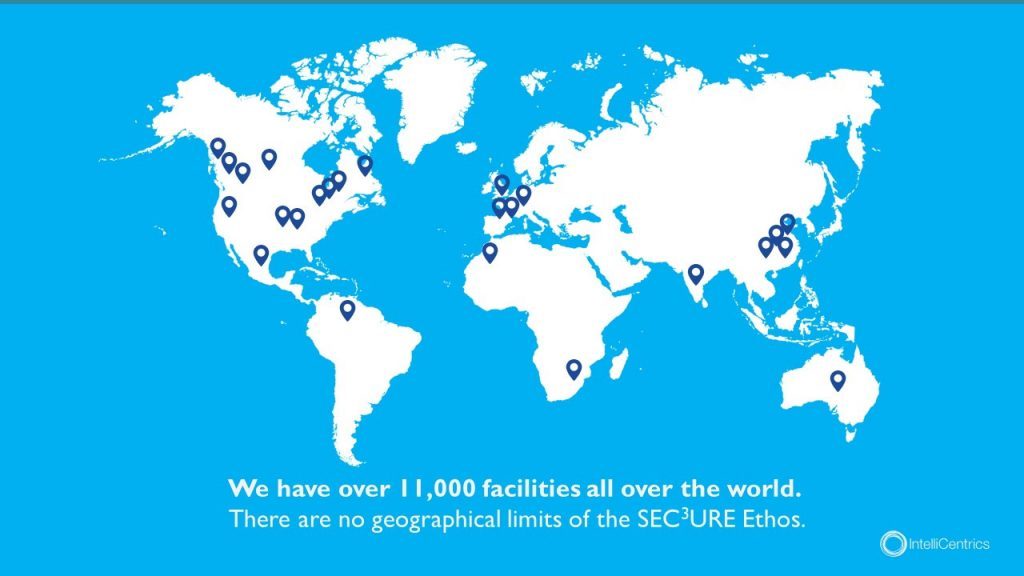
Planning to expand your business? Why not include a map pinpointing all your existing locations relative to your new expansion.
Planning to show how diseases spread throughout the world and relative hotspots of infections? Consider adding a map with varying degrees of color to highlight infection densities.
Maps don’t need to be international either depicting every country – they can be used for small businesses showcasing a localized region.
Lastly, maps help put things into perspective. Tying back to presentation psychology, people are more likely to express emotions or feel connected to something the closer they are to it, physically. By using a map, you can put your message into perspective for your audience.
7 – Infographic Charts & Graphs
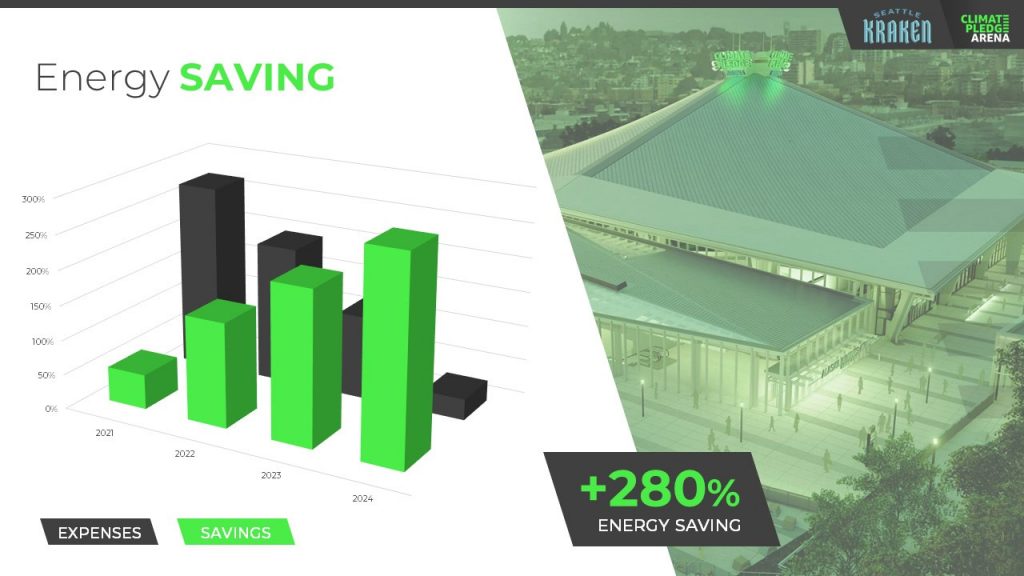
Rather than simply putting a few numbers up on a slide deck and calling it a day, try inputting these numbers in a chart or graph.
You have to consider your audience and not everyone learns or absorbs information by simply reading. They need to visualize comparisons and differences. Charts and graphs are one great way to do this.
Let’s take a look at the example above. It could’ve been easy enough to show there was a 280% increase in energy saving, but we were missing a big chunk of the story which was expenses were declining. You also don’t see the scale of energy savings relative to expenses with just words.
Instead, opting to put numbers into a visual format, the audience members can easily understand the advantages and compare it to the change over time.
Remember – try and avoid very complex graphs. When you start to input complex graphs into a presentation, you’ll begin to lose the audience as they will be too busy focusing on understanding the graph.
If possible, leave the audience with resources they can look back to after the presentation such as a brochure or handout where they can take as much time as they need to digest more robust graphs.
8 – Infographic Diagrams
Unlike charts and graphs which primarily focus on data and numbers, a diagram focuses on the appearance, structure, flow or workings of something.
A diagram is a great presentation aid to use as it helps break complex ideas into step-by-step sections the audience can follow along with.
Not only does it provide clear steps, but it can help speak to key points of a product or timeline.
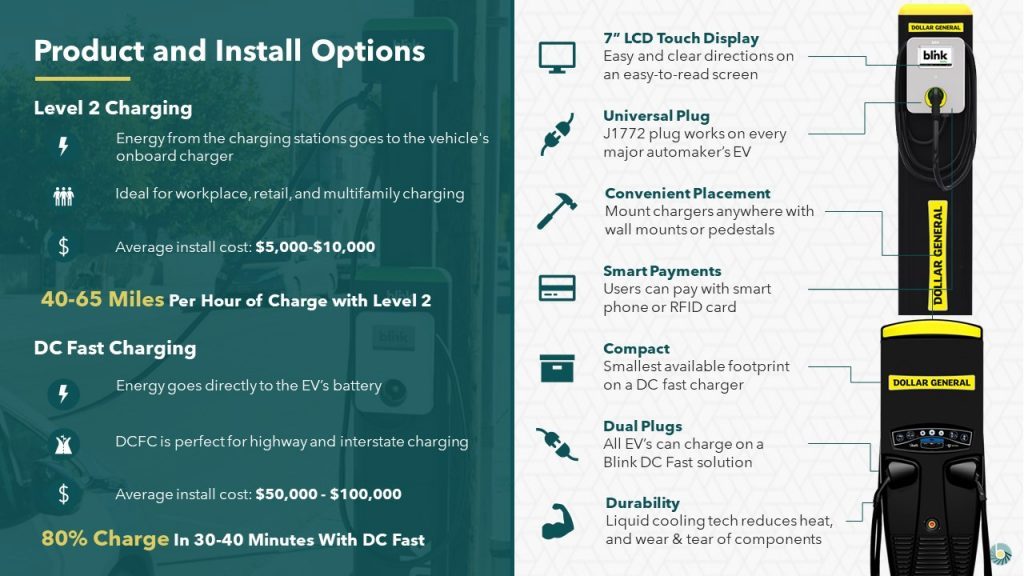
For example, this diagram goes over the structure of an EV charger.
Rather than just showing an image of the charger with bullet points off to the side, a diagram provides clear connection lines from the point being made and where it’s located on the final product.
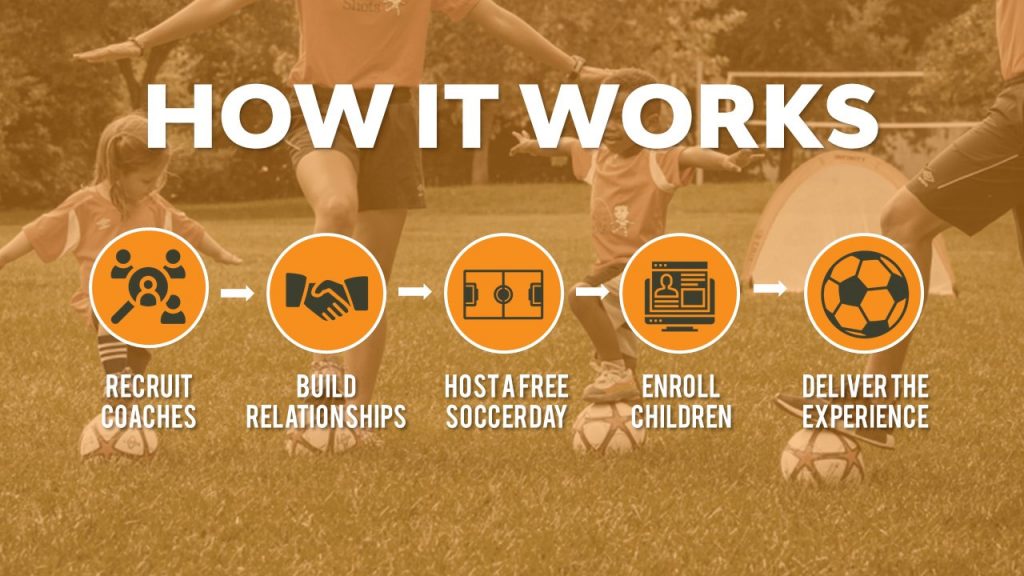
Diagrams also help illustrate flow. Whether it be the customer journey, your product development or your company’s growth, diagrams are great ways to show consistent progression in a logical, step-by-step pattern.
9 – Brochures & Presentation Handouts
One way to really connect with your audience and almost guarantee they’ll leave the presentation remembering something is with a brochure or handout.
A brochure or handout is a physical printout which could be a combination of images, written text and diagrams.
Oftentimes, brochures and handouts are used to elaborate on information already being presented but in further detail. Depending on the scope of your presentation, you may want to opt to have a brochure or presentation handout.
If the nature of your presentation requires thorough research, data and insight such as business or healthcare, a handout can allow your audience to review the information at their own pace at a later time.
A brochure or handout also allows audience members to jot down information.
This is important if you’re trying to encourage audience participation.
By enabling the audience to jot down their own notes and have time near the end of your presentation for them to collaborate and speak to points throughout your presentation, you’ll be engaging in a discourse with your audience.
10 – Demonstration or Live Performance

The last presentation aid we recommend is also one of the hardest to pull off – a demonstration or live performance.
A demonstration or live performance is when you’re presenting the truth and validity of something. For example, you might do a demonstration of how your product performs. Or, instead of playing music, you could have a live performance.
One of the most well-known presenters to do demonstrations or live performances is Steve Jobs. At the unveiling of any new Apple product, Steve Jobs was there on stage with the product in-hand ready to demonstrate its state of the art capabilities.
Demonstration or live performances are one of the best presentation aids to use as they often go hand in hand with public relations. Whether the performance goes well or bad, you can almost be sure there will be press coverage of it afterwards.
A great example of a demonstration which went south was Tesla’s Cybertruck and their armored windows . What was supposed to be strong, armored glass came to a shattering end when a Tesla employee threw a steel ball at not just one window, but both the front and rear window leaving both of them shattered. The hope was for the steel ball to ricochet off the window to demonstrate their durability, but instead they failed.
Although this might seem like a failure, the coverage it got after the presentation was a complete publicity success.
Advantages & Disadvantages Of Using Presentation Aids
As with everything in life, there are always two sides of the coin – positives and negatives.
The same goes for using presentation aids.
Rather than experimenting yourself and learning the hard way of advantages and disadvantages, we’ve put together this short yet informative section to help guide your decision making.
Presentation aids are great complementary tools you should use in every presentation. They allow you to connect with audience members in new and unique ways.
One of the advantages of using presentation aids is to appeal to different audiences.
Everyone has a different attention span. Everyone also learns and absorbs information differently. By disseminating your key message using new and unique methods, you’re able to appeal to a larger audience.
Secondly, presentation aids allow the lifespan of your presentation to be extended.
Imagine your presentation was only you speaking. The moment you’re done talking, the presentation is over and it begins to fade from people’s memory. With the help of presentation aids, you avoid this outcome and extend how long your presentation is remembered for.
For example, if you used a slide deck to accompany your presentation, the slide deck can be made available to audience members after the presentation to reference.
Lastly, presentation aids help reduce the attention that’s put on you and allow you to take breaks while presenting.
If you’re a beginner, it can be intimidating to be the center of attention. With the added use of presentation aids, you can break up your presentation to allow the aids to do the work. If you have a video, once you begin to play it, the audience’s attention will be redirected to the video. This will allow you time to pause, recollect your thoughts, take a drink of water if needed and continue on with the presentation afterwards.
Disadvantages
Presentation aids are not the miracle solution.
If you don’t have a solid foundation on which your presentation is built upon, it doesn’t matter how many or which presentation aids you decide to use. You need to ensure your presentation is properly structured from the beginning.
Presenters can also get carried away with using too many presentation aids.
When you don’t take the time to reflect on the presentation aids you are using and just begin spitballing every presentation aid into your presentation just because you know of these tools, doesn’t mean you should. They begin to become a distraction and takeaway from the messaging you’re trying to get across.
Conclusion – Should You Use Presentation Aids?
The short and sweet answer is yes. You should absolutely use presentation aids.
Unless your plan is to only be a storyteller letting the audience create an image in their mind, then you should consider using at least one of the presentation aid types mentioned above.
Not only will presentation aids help your audience learn and retain the information better, it may actually help you!
Presentation aids require you to contribute more work to the final product. It requires you to carefully think of the story you’re trying to convey to your audience and which best method to do so. By taking this extra bit of time to sit down and reflect on your presentation and actually produce well-crafted aids, you’ll be setting yourself up as a thought-leader on the topic.
If You’re looking for a Pitch Deck Design Agency , we can help. Just click the button below to start your journey!
Author: Ryan
Related posts.

FREE PROFESSIONAL RESOURCES DELIVERED TO YOUR INBOX.
Subscribe for free tips, resources, templates, ideas and more from our professional team of presentation designers.

Want to create or adapt books like this? Learn more about how Pressbooks supports open publishing practices.
15.4 Tips for Preparing Presentation Aids
Learning objectives.
- Understand why it is important to keep presentation aids organized and simple.
- Explain how to make presentation aids easy to see, hear, and understand.
- Make sure your presentation aids work together as a cohesive set.
As we’ve seen earlier in this chapter, impressive presentation aids do not take the place of a well-prepared speech. Although your presentation aids should be able to stand on their own in delivering information, do not count on them to do so. Work toward that goal, but also plan on explaining your presentation aids so that your audience will know why you’re using them.
One mistake you should avoid is putting too much information on an aid. You have to narrow the topic of your speech, and likewise, you must narrow the content of your presentation aids to match your speech. Your presentation aids should not represent every idea in your speech. Whatever presentation aids you choose to use, they should fulfill one or more of the functions described at the beginning of this chapter: to clarify or emphasize a point, to enhance retention and recall of your message, to add variety and interest to your speech, and to enhance your credibility as a speaker.
As a practical matter in terms of producing presentation aids, you may not be aware that many college campuses have a copy service or multimedia lab available to students for making copies, enlargements, slides, and other presentation aids. Find out from your instructor or a librarian what the resources on your campus are. In the rest of this section, we will offer some tips for designing good-quality presentation aids.
Easily Seen or Heard by Your Audience
The first rule of presentation aids is that they must be accessible for every audience member. If those in the back of the room cannot see, hear, or otherwise experience a presentation aid, then it is counterproductive to use it. Graphic elements in your presentation aids must be large enough to read. Audio must be loud enough to hear. If you are passing out samples of a food item for audience members to taste, you must bring enough for everyone.
Do not attempt to show your audience a picture by holding up a book open to the page with the photograph. Nobody will be able to see it. It will be too small for your listeners in the back of the room, and the light will glare off of the glossy paper usually used in books with color pictures so that the listeners in front won’t be able to see it either.
Text-based visuals, charts, and graphs need to be executed with strong, clean lines and blocks of color. Weak lines in a graph or illustration do not get stronger with magnification. You must either strengthen those lines by hand or choose another graphic element that has stronger lines. On a poster or a slide, a graphic element should take up about a third of the area. This leaves room for a small amount of text, rendered in a large, simple font. The textual elements should be located closest to the part of your graphic element that they are about.
Carefully limit the amount of text on a presentation aid. If a great deal of text is absolutely necessary, try to divide it between two slides or posters. Many students believe that even small text will magnify amply when it’s projected, but we find that this is rarely the case. We can’t recommend a specific point size because that refers to the distance between the baselines of two lines of text, not to the size of the type itself.
We recommend two things: First, use a simple, easy-to-read type style. It doesn’t have to be utterly devoid of style, but it should be readable and not distracting. Second, we recommend that you print your text in three or four sizes on a sheet of paper. Place the printed sheet on the floor and stand up. When you look at your printed sheet, you should be able to make a choice based on which clusters of type you are able to read from that distance.
Easily Handled
You should be able to carry your presentation aids into the room by yourself. In addition, you should be skilled in using the equipment you will use to present them. Your presentation aids should not distract you from the delivery of your speech.
Aesthetically Pleasing
For our purposes, aesthetics refers to the beauty or good taste of a presentation aid. Earlier we mentioned the universal principles of good design: unity, emphasis or focal point, scale and proportion, balance, and rhythm. Because of wide differences in taste, not everyone will agree on what is aesthetically pleasing, and you may be someone who does not think of yourself as having much artistic talent. Still, if you keep these principles in mind, they will help you to create attractive, professional-looking visuals.
The other aesthetic principle to keep in mind is that your presentation aids are intended to support your speech, not the other way around. The decisions you make in designing your visuals should be dictated by the content of your speech. If you use color, use it for a clear reason. If you use a border, keep it simple. Whatever you do, make certain that your presentation aids will be perceived as carefully planned and executed elements of your speech.
Tips for Text Aids
Use text only when you must. For example, if you’re presenting an analysis of the First Amendment, it is permissible to display the text of the First Amendment, but not your entire analysis. The type must be big, simple, and bold. It needs white space around it to separate it from another graphic element or cluster of text that might be on the same presentation aid. When you display text, you must read it out loud before you go on to talk about it. That way, you won’t expect your listeners to read one thing while trying to listen to something else. However, under no circumstances should you merely read what’s on your text aids and consider that a speech.
Tips for Graphic Aids
If you create your graphic images, you will have control over their size and the visible strength of the lines. However, you might want to show your listeners an illustration that you can’t create yourself. For instance, you might want to display a photograph of a portion of the Dead Sea Scrolls. First, find a way to enlarge the photograph. Then, to show integrity, cite your source. You should cite your source with an added caption, and you should also cite the source out loud as you display the graphic, even if your photograph is considered to be in the public domain. The NASA photograph “Spaceship Earth” is such an example. Many people use it without citing the source, but citing the source boosts your credibility as a speaker, and we strongly recommend doing so.
Rules for Computer Presentations
Mark Stoner, a professor in the Department of Communication Studies at California State University, Sacramento, has written a useful assessment of the uses and abuses of PowerPoint. Stoner observes that
PowerPoint is a hybrid between the visual and the written. When we pay attention to the design of our writing—to whether we are putting key word at the beginning or end of a sentence, for instance—we are likely to communicate more effectively. In the same way, it makes sense to understand the impact that PowerPoint’s design has on our ability to communicate ideas to an audience (Stoner, 2007).
While this article is specifically about PowerPoint, Stoner’s advice works for all presentation software formats. Presentation aids should deliver information that is important or is difficult to present with spoken words only. Although many speakers attempt to put their entire speech on PowerPoint slides or other visual aids, this is a bad idea for several reasons. First, if you try to put your entire speech on PowerPoint, you will lose contact with your audience. Speakers often end up looking at the projected words or directly at the computer screen instead of at their audience. Second, your vocal delivery is likely to suffer, and you will end up giving a boring reading, not a dynamic speech. Third, you will lose credibility, as your listeners question how well you really know your topic. Fourth, you are not using the presentation aids to clarify or emphasize your message, so all the information may come across as equally important.
No matter what presentation software package you decide to utilize, there are some general guidelines you’ll need to follow.
Watch Your Font
One of the biggest mistakes novice users of presentational software make is thinking that if you can read it on the screen, your audience will be able to read it in their seats. While this may be the case if you’re in a close, intimate conference room, most of us will be speaking in situations where audience members are fifteen feet away or more. Make sure each slide is legible from the back of the room where you will be speaking.
Don’t Write Everything Out
In addition to watching your font size, you also need to watch how you use words on the screen. Do not try to put too much information on a slide. Make sure that your slide has the appropriate information to support the point you are making and no more. We strongly recommend avoiding complete sentences on a slide unless you need to display a very important direct quotation.
Don’t Bow Down to the Software
Remember, presentation software is an aid, so it should aid and not hinder your presentation. We have seen too many students who only end up reading the slides right off the screen instead of using the slides to enhance their presentations. When you read your slides right off the projector screen, you’re killing your eye contact. As a general word of advice, if you ever find yourself being forced to turn your back to the audience to read the screen, then you are not effectively using the technology. On the flip side, you also shouldn’t need to hide behind a computer monitor to see what’s being projected.
Slide Color
Color is very important and can definitely make a strong impact on an audience. However, don’t go overboard or decide to use unappealing combinations of color. For example, you should never use a light font color (like yellow) on a solid white background because it’s hard for the eye to read.
You should also realize that while colors may be rich and vibrant on your computer screen at home, they may be distorted by a different monitor. While we definitely are in favor of experimenting with various color schemes, always check your presentation out on multiple computers to see if the slide color is being distorted in a way that makes it hard to read.
Slide Movement
Everyone who has had an opportunity to experiment with PowerPoint knows that animation in transitions between slides or even on a single slide can be fun, but often people do not realize that too much movement can actually distract audience members. While all presentation software packages offer you very cool slide movements and other bells and whistles, they are not always very helpful for your presentation. If you’re going to utilize slide transitions or word animation, stick to only three or four different types of transitions in your whole presentation. Furthermore, do not have more than one type of movement on a given slide. If you’re going to have all your text come from the right side of the screen in a bulleted list, make sure that all the items on the bulleted list come from the right side of the screen.
Practice, Practice, Practice
It is vital to practice using the technology. Nothing is worse than watching a speaker stand up and not know how to turn on the computer, access the software, or launch his or her presentation. When you use technology, audiences can quickly see if you know what you are doing, so don’t give them the opportunity to devalue your credibility because you can’t even get the show going.
Always Have a Backup Plan
Lastly, always have a backup plan. Unfortunately, things often go wrong. One of the parts of being a professional is keeping the speech moving in spite of unexpected problems. Decide in advance what you will do if things break down or disappear right when you need them. Don’t count on your instructor to solve such predicaments; it is your responsibility. If you take this responsibility seriously and check the room where you will be presenting early, you will have time to adapt. If the computer or audiovisual setup does not work on the first try, you will need time to troubleshoot and solve the problem. If an easel is missing, you will need time to experiment with using a lectern or a chair to support your flip chart. If you forgot to bring your violin for a speech about music—don’t laugh, this actually happened to a friend of ours!—you will need time to think through how to adapt your speech so that it will still be effective.
Key Takeaways
- Presentation aids must be organized and simple. The universal principles of good design can be a useful guide.
- Material in presentation aids must be limited in quantity. Remember, presentation aids are supposed to aid a speech, not become the speech itself.
- Presentation aids must visually look like they were designed as a set. When presentation aids look unprofessional, they can decrease a speaker’s credibility.
- Always practice with your presentation aids, and be prepared for unexpected problems.
- Examine Figure 15.14 “World Populations” in this chapter. How could you go about making this visual aid more understandable?
- Create a new presentation aid for a previous speech given in your public speaking class. How could that aid have helped your overall speech?
- Take some time to explore the presentation software packages discussed in Table 15.1 “Presentation Software Packages” What do you see as some of the advantages and disadvantages of the different software packages?
Stoner, M. (2007). Uncovering the powers within PowerPoint. Communication Currents , 2 (4). Retrieved from http://www.natcom.org/CommCurrentsArticle.aspx?id=819
Stand up, Speak out Copyright © 2016 by University of Minnesota is licensed under a Creative Commons Attribution-NonCommercial-ShareAlike 4.0 International License , except where otherwise noted.
Share This Book

- school Campus Bookshelves
- menu_book Bookshelves
- perm_media Learning Objects
- login Login
- how_to_reg Request Instructor Account
- hub Instructor Commons
- Download Page (PDF)
- Download Full Book (PDF)
- Periodic Table
- Physics Constants
- Scientific Calculator
- Reference & Cite
- Tools expand_more
- Readability
selected template will load here
This action is not available.

13: Presentation Aids- Design and Usage
- Last updated
- Save as PDF
- Page ID 79718
What Are Presentation Aids?

Lex McKee - Death by PowerPoint - CC BY-NC 2.0.
When you give a speech, you are presenting much more than just a collection of words and ideas. Because you are speaking “live and in person,” your audience members will experience your speech through all five of their senses: hearing, vision, smell, taste, and touch. In some speaking situations, the speaker appeals only to the sense of hearing, more or less ignoring the other senses except to avoid visual distractions by dressing and presenting himself or herself in an appropriate manner. But the speaking event can be greatly enriched by appeals to the other senses. This is the role of presentation aids.
Presentation aids, sometimes also called sensory aids, are the resources beyond the speech itself that a speaker uses to enhance the message conveyed to the audience. The type of presentation aids that speakers most typically make use of are visual aids: pictures, diagrams, charts and graphs, maps, and the like. Audible aids include musical excerpts, audio speech excerpts, and sound effects. A speaker may also use fragrance samples or a food samples as olfactory or gustatory aids. Finally, presentation aids can be three-dimensional objects, animals, and people; they can unfold over a period of time, as in the case of a how-to demonstration
As you can see, the range of possible presentation aids is almost infinite. However, all presentation aids have one thing in common: To be effective, each presentation aid a speaker uses must be a direct, uncluttered example of a specific element of the speech. It is understandable that someone presenting a speech about Abraham Lincoln might want to include a picture of him, but because most people already know what Lincoln looked like, the picture would not contribute much to the message (unless, perhaps, the message was specifically about the changes in Lincoln’s appearance during his time in office). Other visual artifacts are more likely to deliver information more directly relevant to the speech—a diagram of the interior of Ford’s Theater where Lincoln was assassinated, a facsimile of the messy and much-edited Gettysburg Address, or a photograph of the Lincoln family, for example. The key is that each presentation aid must directly express an idea in your speech.
Moreover, presentation aids must be used at the time when you are presenting the specific ideas related to the aid. For example, if you are speaking about coral reefs and one of your supporting points is about the location of the world’s major reefs, it will make sense to display a map of these reefs while you’re talking about location. If you display it while you are explaining what coral actually is, or describing the kinds of fish that feed on a reef, the map will not serve as a useful visual aid—in fact, it’s likely to be a distraction.
Presentation aids must also be easy to use. At a conference on organic farming, your author watched as the facilitator opened the orientation session by creating a conceptual map of our concerns, using a large newsprint pad on an easel. In his shirt pocket were wide-tipped felt markers in several colors. As he was using the black marker to write the word “pollution,” he dropped the cap on the floor, and it rolled a few inches under the easel. When he bent over to pick up the cap, all the other markers fell out of his pocket. They rolled about too, and when he tried to retrieve them, he bumped the easel, leading the easel and newsprint pad to tumble over on top of him. The audience responded with amusement and thundering applause, but the serious tone of his speech was ruined. The next two days of the conference were punctuated with allusions to the unforgettable orientation speech. This is not how you will want your speech to be remembered.
To be effective, presentation aids must also be easy for the listeners to see and understand. In this chapter, we will present some principles and strategies to help you incorporate hardworking, effective presentation aids into your speech. We will begin by discussing the functions that good presentation aids fulfill. Next, we will explore some of the many types of presentation aids and how best to design and utilize them. We will also describe various media that can be used for presentation aids. We will conclude with tips for successful preparation and use of presentation aids in a speech.
- 13.1: Functions of Presentation Aids Adapted from Stand Up, Speak Out: The Practice and Ethics of Public Speaking, Chapter 15.1
- 13.2: Types of Presentation Aids Adapted from Stand Up, Speak Out: The Practice and Ethics of Public Speaking, Chapter 15.2
- 13.3: Media to Use for Presentation Aids Adapted from Stand Up, Speak Out: The Practice and Ethics of Public Speaking, Chapter 15.3
- 13.4: Tips for Preparing Presentation Aids Adapted from Stand Up, Speak Out: The Practice and Ethics of Public Speaking, Chapter 15.4
- 13.5: Chapter Exercises Adapted from Stand Up, Speak Out: The Practice and Ethics of Public Speaking, Chapter 15.5

IMAGES
VIDEO
COMMENTS
Today's crossword puzzle clue is a quick one: Presentation aid. We will try to find the right answer to this particular crossword clue. Here are the possible solutions for "Presentation aid" clue. It was last seen in Newsday quick crossword. We have 3 possible answers in our database.
Presentation aids. Today's crossword puzzle clue is a quick one: Presentation aids. We will try to find the right answer to this particular crossword clue. Here are the possible solutions for "Presentation aids" clue. It was last seen in The Wall Street Journal quick crossword. We have 1 possible answer in our database.
Visual aids help clarify and contextualize your points for your audience. Whether you deliver your presentation in person or over the web, the goal is to clearly communicate with your audience. Presentation aids help achieve this goal. Visual aids also help a presenter stay on a predefined train of thought while presenting.
Presentation aids are the resources beyond the speech itself that a speaker uses to enhance the message conveyed to the audience. The type of presentation aids that speakers most typically make use of are visual aids: pictures, diagrams, charts and graphs, maps, and the like. Audible aids include musical excerpts, audio speech excerpts, and ...
Presentation aids are the resources beyond the speech words and delivery that a speaker uses to enhance the message conveyed to the audience. The type of presentation aids that speakers most typically make use of are visual aids: pictures, diagrams, charts and graphs, maps, and the like. Audible aids include musical excerpts, audio speech ...
Presentation aids should help audiences more thoroughly understand a speaker's basic message. There are four basic reasons to use presentation aids. First, they increase audience understanding of a speaker's message. Second, they help audiences retain and recall a speaker's message after the fact. Third, they make a speech more ...
This is the role of presentation aids. Presentation aids are the resources beyond the speech words and delivery that a speaker uses to enhance the message conveyed to the audience. The type of presentation aids that speakers most typically make use of are visual aids: slideshows, pictures, diagrams, charts and graphs, maps, and the like.
The type of presentation aids speakers most typically use are visual aids: pictures, diagrams, charts and graphs, maps, and the like. Audible aids include musical excerpts, audio speech excerpts, and sound effects. A speaker may also use fragrance samples or food samples as olfactory (smell) or gustatory (taste) aids.
Today's crossword puzzle clue is a quick one: ___ pointer (presentation aid). We will try to find the right answer to this particular crossword clue. Here are the possible solutions for "___ pointer (presentation aid)" clue. It was last seen in Daily celebrity quick crossword. We have 1 possible answer in our database.
By Judhajit Sen / April 25, 2024. Key Takeaways. Diverse Tools for Engagement: Different types of presentation aids, including images, graphs, diagrams, maps, audio and video aids, handouts, and demonstrations, enhance engagement by targeting various senses and learning styles and helping the audience to understand your message.
Presentation aids are the resources beyond the speech words and delivery that a speaker uses to enhance the message conveyed to the audience. The type of presentation aids that speakers most typically make use of are visual aids: pictures, diagrams, charts and graphs, maps, and the like. Audible aids include musical excerpts, audio speech ...
Presentation aids. the resources beyond the speech itself that a speaker uses to enhance the message conveyed to the audience. Olfactory. of or relating to the sense of smell. Gustatory. of or relating to the sense of taste. As you can see, the range of possible presentation aids is almost infinite. However, all presentation aids have one thing ...
For most audiences, statistical presentations must be kept as simple as possible, and they must be explained. The statistical chart shown in Figure 13.2.2 13.2. 2 "Birth Weight Chi-Square" is from a study examining the effects of maternal smoking on a range of congenital birth defects.
Old-school presentation aids. Today's crossword puzzle clue is a quick one: Old-school presentation aids. We will try to find the right answer to this particular crossword clue. Here are the possible solutions for "Old-school presentation aids" clue. It was last seen in Daily quick crossword. We have 1 possible answer in our database.
2 - Visual Aids, Audio And Video Clips. At a minimum, you should have at least one of the following presentation aids - imagery, audio or video. Imagery can be more than just a photo. Imagery encompasses your slide deck, the color theory you use such as brand colors, how you embellish quotes and more.
Presentation aids must be organized and simple. The universal principles of good design can be a useful guide. Material in presentation aids must be limited in quantity. Remember, presentation aids are supposed to aid a speech, not become the speech itself. Presentation aids must visually look like they were designed as a set.
Sales presentation aid. Today's crossword puzzle clue is a quick one: Sales presentation aid. We will try to find the right answer to this particular crossword clue. Here are the possible solutions for "Sales presentation aid" clue. It was last seen in The Wall Street Journal quick crossword. We have 1 possible answer in our database.
Presentation aid s are the resources beyond the speech words and delivery that a speaker uses to enhance the message conveyed to the audience. The type of presentation aids that speakers most typically make use of are visual aids: pictures, diagrams, charts and graphs, maps, and the like. Audible aids include musical excerpts, audio speech ...
Presentation aids must be organized and simple. The universal principles of good design can be a useful guide. Material in presentation aids must be limited in quantity. Remember, presentation aids are supposed to aid a speech, not become the speech itself. Presentation aids must visually look like they were designed as a set.
Get excited at church painting as presentation aid (Two words) - crossword puzzle clues and possible answers. Dan Word - let me solve it for you! ... Today's crossword puzzle clue is a cryptic one: Get excited at church painting as presentation aid (Two words). We will try to find the right answer to this particular crossword clue. Here are the ...
Answers for presentation aid/999473 crossword clue, 5 letters. Search for crossword clues found in the Daily Celebrity, NY Times, Daily Mirror, Telegraph and major publications. Find clues for presentation aid/999473 or most any crossword answer or clues for crossword answers.
This is the role of presentation aids. Presentation aids, sometimes also called sensory aids, are the resources beyond the speech itself that a speaker uses to enhance the message conveyed to the audience. The type of presentation aids that speakers most typically make use of are visual aids: pictures, diagrams, charts and graphs, maps, and the ...